

How to Draw a Boat – An Easy and Realistic Boat Drawing Tutorial
Ahoy there! You are invited on an exciting voyage of artistic discovery today as we learn how to draw a ship, much like those used for the first around-the-world trips. We break this quite complex boat down into very easy-to-follow steps, making this tutorial suitable for artists of any level. If you are ready to set sail, gather your supplies and let us jump right in!
Table of Contents
- 1.1 Step 1: Shape the Main Body of the Boat Sketch
- 1.2 Step 2: Outline Some Details
- 1.3 Step 3: Draw the Sails
- 1.4 Step 4: Add In the Railing and Ropes
- 1.5 Step 5: Draw the Ocean and the Oars
- 1.6 Step 6: Create Texture Within Your Realistic Boat Drawing
- 1.7 Step 7: Add Some Light Texture to the Waves
- 1.8 Step 8: Begin Coloring the Wood of Your Boat Sketch
- 1.9 Step 9: Color the Sails
- 1.10 Step 10: Add Some Color to the Ocean
- 1.11 Step 11: Start Contouring Your Boat Drawing
- 1.12 Step 12: Continue Shading Your Boat Sketch
- 1.13 Step 13: Start Shading the Sails
- 1.14 Step 14: Darken the Shading on the Sails
- 1.15 Step 15: Apply Highlights To Your Drawing of a Boat
- 1.16 Step 16: Create Three-Dimensions in the Water
- 1.17 Step 17: Highlight the Ocean Waves
- 1.18 Step 18: Finishing Your Boat Drawing
- 2.1 How to Make Boat Drawing Easy?
- 2.2 What Colors Do You Need for a Drawing of a Boat?
Step-by-Step Realistic Boat Drawing Tutorial
You can see from the main image that the boat sketch we are going to do today is quite complex. There are many small details and tricky elements, but we have tried to make boat drawing easy for all artists. We begin the tutorial with several simple steps that help us to build up the final shape of the boat drawing. We then begin to add the smaller details, before using color to bring our boat drawing to life.
You can see an outline of the different steps in the collage below.
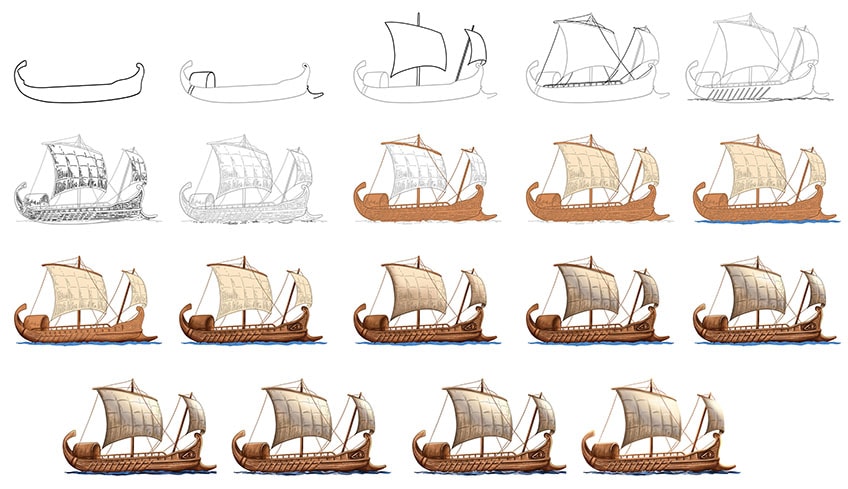
Most of the realism in our drawing of a boat comes from the coloring steps. Whenever you begin learning how to draw a new subject, we find it best to use a coloring medium that you feel most comfortable with. Whether you are a digital artist or prefer physical mediums, you can simply adjust the instructions to suit your needs. If you are using a physical medium, like paint, we suggest using a light pencil for the initial construction and outlining steps. For digital mediums, use a separate layer for these steps.
If you are ready to dive right in, find somewhere comfortable to sit, and let us begin!
Step 1: Shape the Main Body of the Boat Sketch
We are going to begin our boat drawing by creating the basic shape of the hull. Start by finding the central point of your drawing area, and begin drawing the long curved shape. The shape is like a canoe, with a curve up and in on either end.

Step 2: Outline Some Details
We are now going to begin adding some smaller details. Begin on the far left end of the boat sketch, drawing a curving canopy shape. Add a small narrow band around the base of the boat drawing below this canopy, and then add a small tear-drop shape in the front point of the boat.
You can also add a small rope-like protrusion from the front (right side).

Step 3: Draw the Sails
In this step, we are going to draw the main sail and the front sail of our boat sketch. Begin with the main sail, a large curving rectangle above the middle part of the boat. You can then draw a long mast behind this sail, extending from the base of the boat and up above the top of the sail. You can then draw a smaller and more angled sail above the front bow of the boat.
Again, you can draw the mast which should be angled towards the right side of your canvas and extend slightly above the sail.
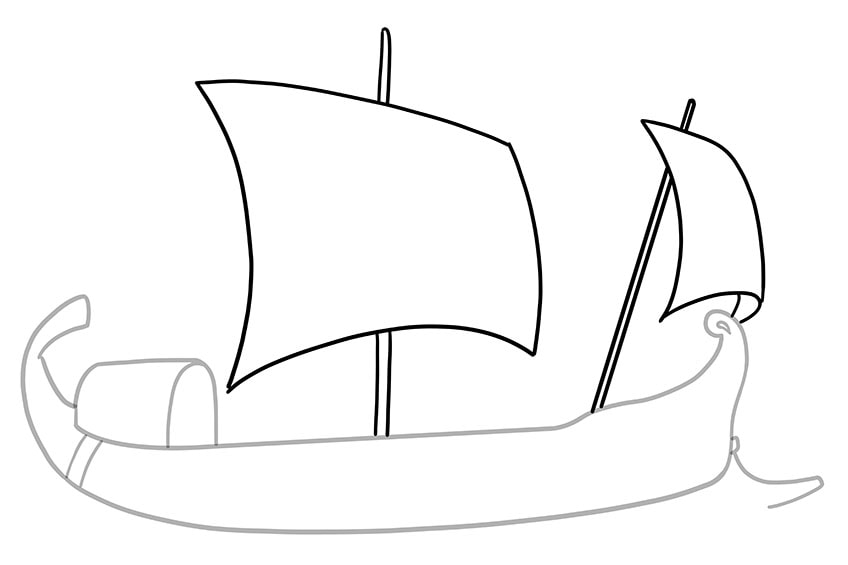
Step 4: Add In the Railing and Ropes
There are two main objectives for this step. Firstly, we are going to draw the railing of the deck, and then we are going to add the sail ropes. Let us begin with the barrier, starting with a curving shape that extends along most of the length of the boat. Then, using equally spaced lines, create several support beams. To complete this step, you are going to add the ropes for the sail. Begin by adding a bar along the top of each sail, and then draw several ropes that extend from the top of the masts to each corner of the sails.
You can also draw some ropes that join the sails to the deck of the boat.
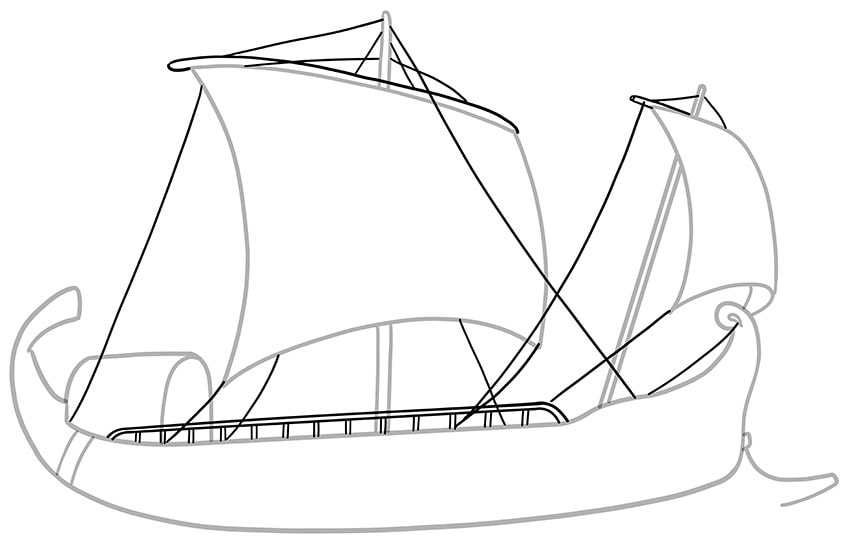
Step 5: Draw the Ocean and the Oars
We are now going to add some context to your boat drawing. Begin by creating some gentle ocean waves around the base of the boat drawing. You can then draw some oars that extend from the side of the ship down into these waves. Generally, the oars should be facing backward, but you can create some variation in their angles for additional realism.

Step 6: Create Texture Within Your Realistic Boat Drawing
Things are starting to get exciting now. At this stage, we have the basic elements of our boat drawing complete, and we also have some of the finer details. We are now going to add some textural details to the sails and bow. Let us begin with the sails, using some fine horizontal and vertical lines to create a series of blocks.
Within these blocks, add some fine texture lines to emphasize the three-dimensionality.
Next, using fine and long strokes that follow the shape of the bow, create some wooden plank details. Create texture within these planks, and use fine lines to add more texture where you think it is necessary. As a final detailed touch, draw a wooden eye on the front of the boat sketch.

Step 7: Add Some Light Texture to the Waves
We are now going to add some final texture to our sketch before we begin using color. Within the shape of the waves, create some fine arched lines that represent a realistic ocean wave texture.

Step 8: Begin Coloring the Wood of Your Boat Sketch
In order to create our realistic boat drawing, we are going to build the color up gradually. In this step, we are going to add a base coat of color to the wooden parts of our boat sketch. Use a regular paintbrush and a light brown shade of paint for this.
Fill the base of the boat with an even coat of color, and then move on to the masts.

Step 9: Color the Sails
We are now going to complete our base color coat by coloring the sails. Use a regular paintbrush and a light shade of cream paint to carefully color the main sail and the front sail.

Step 10: Add Some Color to the Ocean
Let us now move on to the ocean, using some light blue paint to fill in the waves surrounding the base of your boat drawing.

Step 11: Start Contouring Your Boat Drawing
Now that we have the base colors down, we are going to begin adding more structure. For this step, you are going to need a small blending brush and a touch of black paint. Begin to add some definitions between the panels of wood on the side of your boat drawing. You can also add some shading to the masts, the oars, and the back curve of your ship.
Tip: When using black for contouring or shading, always begin very lightly and darken as you need to. Black is almost impossible to remove once you have applied it.

Step 12: Continue Shading Your Boat Sketch
We are now going to continue shading our drawing of a boat with a slightly finer tough. Use a sharp detailing brush and some black paint to add some fine shading along the details on the side of your boat. This will include things like shading around the eye, between each of the planks of wood, and within the canopy.
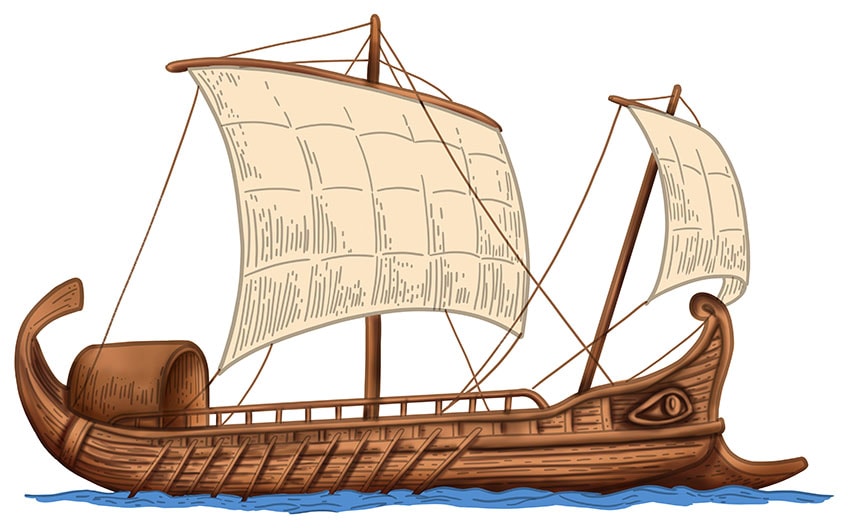
Step 13: Start Shading the Sails
Let us now move on to the sails. With a blending brush and the same brown that you used as the base coat for the boat, create a gentle blend of color up the sails. The bottom and sides of the sails should be slightly darker, and blend smoothly into the lighter cream color at the top.
Tip: For an extra smooth transition, you can use a clean blending brush to carefully all of these colors together.
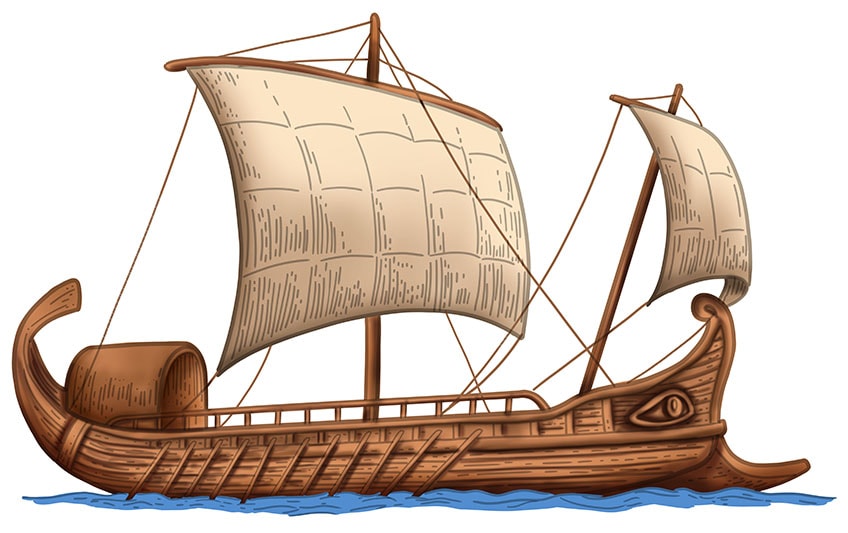
Step 14: Darken the Shading on the Sails
As we did with the body of our boat drawing, we are now going to add more detailed shadows to the sails. With a small blending brush and some dark grey paint, add shadows on top of the textured areas. The grey shading should mostly be focused around the pleats in the sails, around the edges, and above the texture lines.
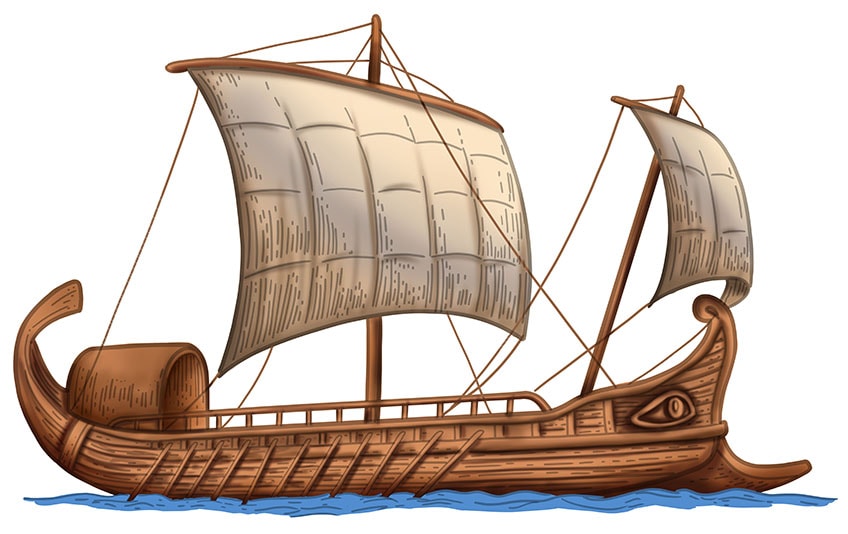
Step 15: Apply Highlights To Your Drawing of a Boat
The last few steps have focused on creating darkness within our boat drawing. We are now going to begin to contrast these shadows with a touch of highlighting. With a blending brush and some white paint, begin by creating a faded highlight on the lightest areas of the sails. Then, with a more detailed brush and white paint, apply highlights to the areas of the boat that are most likely to catch the light. These areas include the top of the canopy, the top of the masts, the railing, and on top of the ores.
Tip: When creating highlights, it is easiest to pick a light source. You can then imagine where the light would hit from that angle.

Step 16: Create Three-Dimensions in the Water
We are now going to shift our focus to creating structure within the waves. With a small blending brush and a touch of black paint, apply some light shading along the edges of the water. You can shade beneath the wave lines that you drew previously, giving the impression of moving water.

Step 17: Highlight the Ocean Waves
Just before we finish our realistic boat drawing, we are going to add a few spots of highlight to the water surface. Use a small blending brush and some white paint to apply short strokes of light onto the water surface.

Step 18: Finishing Your Boat Drawing
In this last step, we are going to add some final spots of water spray and then remove the outline. Begin by using a small blending brush and some white paint to create some realistic water splashes against the side of the boat. You can then remove the dark outline form your boat drawing, leaving you with a seamlessly realistic sketch. Use a fine detailing brush and the corresponding color at each point of the outline to carefully trace over it. You can do the same for any inner texture lines.

We really hope you have enjoyed your voyage of discovery today! As with all of our drawing tutorials , we hope that we have made boat drawing easy for artists of any levels. You now know how to draw a ship of any kind, following the same basic process.
Frequently Asked Questions
How to make boat drawing easy.
Learning how to draw a ship can seem like a daunting task. Fortunately, we make it really easy by breaking the process down into easy-to-follow steps. We begin with simple shapes, creating the basic outline of our boat sketch. We then build up a realistic boat drawing by using color to create detail and dimension.
What Colors Do You Need for a Drawing of a Boat?
You only need a few basic colors for this easy and realistic boat drawing. Firstly, you will need several different shades of brown , including one very light cream and a slightly darker shade. You will then also need white, black, and grey for the contouring, Finally, you will need a sea blue shade for the ocean waves around the base of your boat.

Matthew Matthysen is an educated multidisciplinary artist and illustrator. He successfully completed his art degree at the University of Witwatersrand in South Africa, majoring in art history and contemporary drawing. The focus of his thesis was to explore the philosophical implications of the macro and micro-universe on the human experience. Matthew uses diverse media, such as written and hands-on components, to explore various approaches that are on the border between philosophy and science.
Matthew organized various exhibitions before and during his years as a student and is still passionate about doing so today. He currently works as a freelance artist and writer in various fields. He also has a permanent position at a renowned online gallery (ArtGazette) where he produces various works on commission. As a freelance artist, he creates several series and successfully sells them to galleries and collectors. He loves to use his work and skills in various fields of interest.
Matthew has been creating drawing and painting tutorials since the relaunch in 2020. Through his involvement with artincontext.org, he has been able to deepen his knowledge of various painting mediums. For example, watercolor techniques, calligraphy and lately digital drawing, which is becoming more and more popular.
Learn more about Matthew Matthysen and the Art in Context Team .
Similar Posts

How to Draw Feet – Feet Drawing Tutorial in 8 Steps

T-Rex Coloring Pages – 30 Free Coloring Sheets
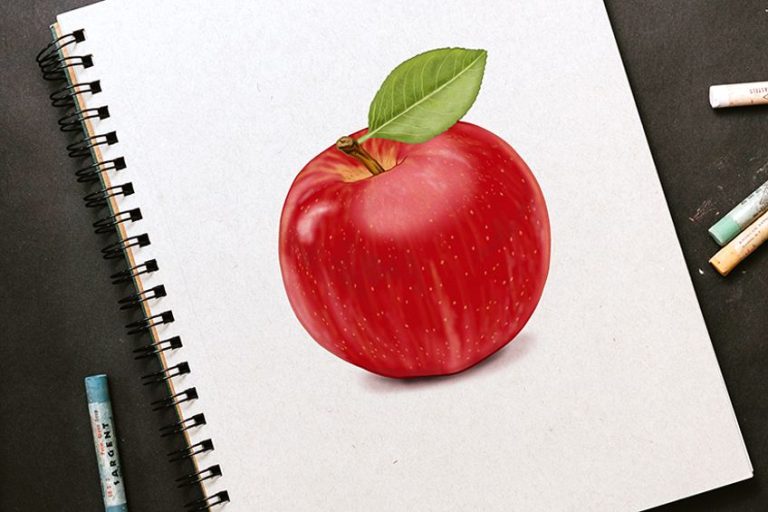
How to Draw an Apple – Our Fun Fruit Illustration Tutorial

How to Draw a Chair – Creating a Three-Dimensional Chair Sketch
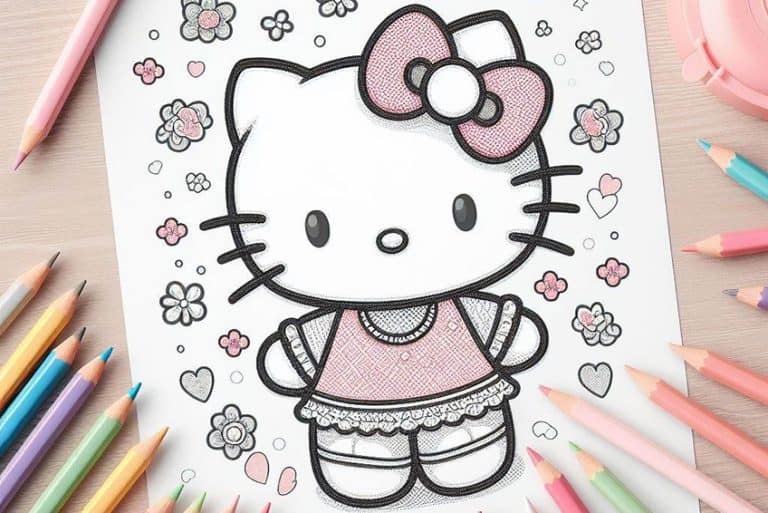
Hello Kitty Coloring Pages – 56 Cute Coloring Sheets

Avengers Coloring Pages – 46 Action-Packed Coloring Sheets
Leave a reply cancel reply.
Your email address will not be published. Required fields are marked *
Save my name, email, and website in this browser for the next time I comment.

How to Draw A Sailboat – A Step by Step Guide
Sailboat drawing in just 6 easy steps.
Sailing the seven seas is one of the most adventurous and liberating activities you can partake in, and if you wanted to do that then a sailboat would be your best bet!
These small watercraft can help you effortlessly glide across the ocean as you search for adventure.
Owning a sailboat isn’t something available to everyone, unfortunately, but learning how to draw a sailboat can be the next best thing.
By the end of this guide, you will know how to do just that!
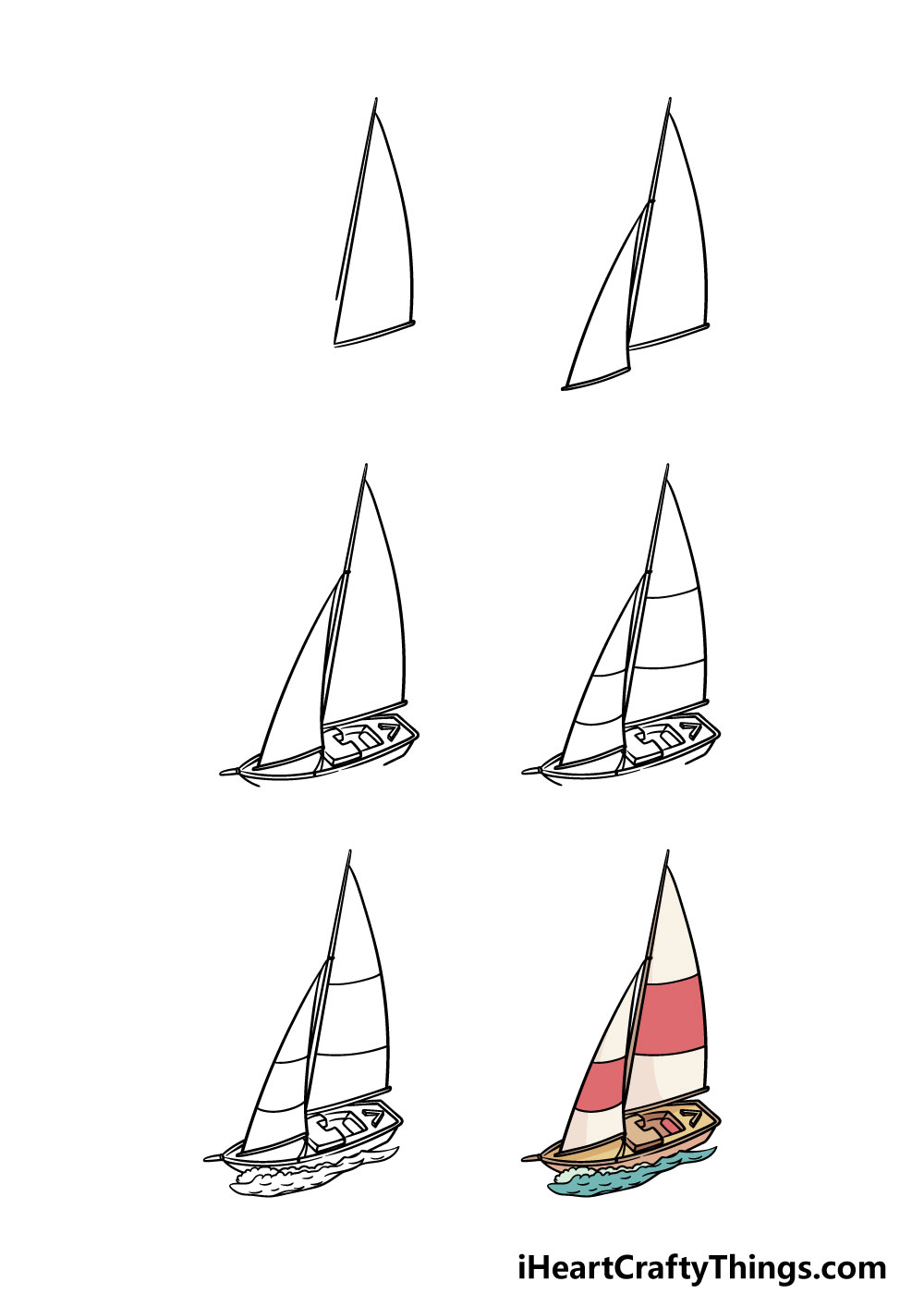
How to Draw A Sailboat – Let’s get Started!
To get this guide on how to draw a sailboat going, we will begin with the sail first. You can start off by drawing the frame of the sail, which will be drawn using two straight lines very close to one another.
Then, we will be extending a curved line down from the top of this frame towards the base.
This will form the sheet of the sail. At the base of the sheet, you can add two more lines close to one another for the bottom frame of the sail.
Once you have drawn these, you are ready to continue to step 2!
Step 2 – Next, draw another sheet for the sails
Now that you have one sheet done for the sails of your sailboat drawing, we can add another one in this second step.
This sail will be similarly shaped to the previous one, except it will be reversed and won’t have the same vertical straight frame that the other one did.
It will also be smaller and lower down than the previous one was, but it will have a similar straight frame at the bottom of it.
Once you have drawn it and positioned it as it appears in our reference image we can move on to the next part.
Step 3 – Now, draw the boat itself
You’re finished with the ‘sail’ part of the sailboat, and now you can start on the ‘boat’ aspect in this step of our guide on how to draw a sailboat.
The boat will be seen from the top down, and to draw the outline you can use some curved lines for the side that culminate at the tip at the front. The back of the boat will be drawn with straight lines instead.
These outlines will then have a second outline close to those lines, and once you have that you can add some of the interior details.
These details will be drawn with some straight-edged shapes for the area sailors would be seated in along with some other details.
You can then finish off this step with two short curved lines at the front and back of the boat for the start of the base.
Step 4 – Next, draw some details for the sails
The next few steps of this guide will be all about adding the final details, elements and touches to your sailboat drawing.
For now, we will add some details to the sails, and these details will be quite easy to add! All you need to do is draw some slightly curved lines horizontally across the sails.
You could also decorate the sails with a different pattern if you would like to! What patterns can you think of for the sails?
Step 5 – Now, finish off your sailboat drawing
This fifth step of this guide on how to draw a sailboat will see you adding some final details and elements.
For this step, we will be using some curved and bumpy lines to show the water breaking underneath the boat. Once you have drawn these water details you have finished all of the details in the guide!
Before you move on, you can also add some details of your own to put your own spin on it. You could draw some people sitting in the sailboat or some different pattern details on the sails.
Perhaps you could also draw some dolphins or whales jumping out the water or draw a beautiful background for it.
These are just a few ideas you could go for and you should be sure to get creative and have fun with, so be sure to express yourself and see what happens!
Step 6 – Finish off your sailboat drawing with some color
For the final step of your sailboat drawing, you will be finishing it off by adding some amazing colors to your drawing.
In our reference image, we showed one set of colors that you could go for, but these colors are just a suggestion.
For this step, you should feel free to incorporate any of your favorite colors to really bring this image to life!
There are no limits to the colors that you could use for this image, so be sure to get creative with it.
Once you know which colors you would like to use, you can then decide on the art mediums and tools you will use to add them.
You could use some acrylic paints and colored pens for some brighter colors that pop. Some watercolors or colored pencils would be ideal for more muted and subdued colors instead.
Either approach would look amazing, so what do you think you will go for?
5 Tips To Make Your Sailboat Drawing Even Better!
Get this sailboat sketch seaworthy with these helpful tips and tricks!
With this sailboat drawing, we kept the focus on the sailboat itself. That means we showed only a bit of the water surrounding the boat.
If you wanted to add more context to this artwork, you could add more water and waves around the sailboat. These could be calm and tranquil or rough and dangerous.
It all depends on what sort of scene you would like, and anything you choose will look cool!
Once you have worked on the water, you could then add even more to the background of this drawing of a sailboat. Even though you are depicting the sea, you would have many options!
There could be some desert islands, sea creatures or maybe even a bigger ship in the background. What are some other features you could add to this artwork?
With this sailboat as it appears now, there are no people on it to enjoy the sailing. It would be a small detail, but it could be fun to add some people on the sailboat!
Depending on how big you made the boat, they could be detailed or look like small dots on the boat. How many people would you add to the boat?
We showed a nice design for the sail featured on this sailboat sketch, but this is an area that you could have a lot of fun customizing!
This is your chance to create your very own sail design to show what your dream sailboat would look like. This design could use any shapes, images or text that you like.
What should this sail look like?
Finally, you can finish it all off with some colors. We showed you some you can use for your sailboat drawing, but these are far from the only ones you can go for!
Choosing the colors is just the first step, and choosing the art tools and mediums is the next. Mixing colors and mediums for different textures and sections can also make it look even cooler!
Your Sailboat Drawing is Complete!
You have completed all six steps of this guide on how to draw a sailboat, and you have a great picture to show for it!
We hope that you enjoyed this drawing adventure, and that this guide made taking on this drawing fun and easy for you to do!
Then, you can take this drawing even further with your own extra additions and elements. We mentioned a few ideas like adding some people in the boat or a background, but this is your chance to get creative! How will you put your own spin on this drawing?
When you’re ready for more fun, our website is full of awesome drawing guides for you to enjoy. We upload new ones often, so be sure to keep checking in!
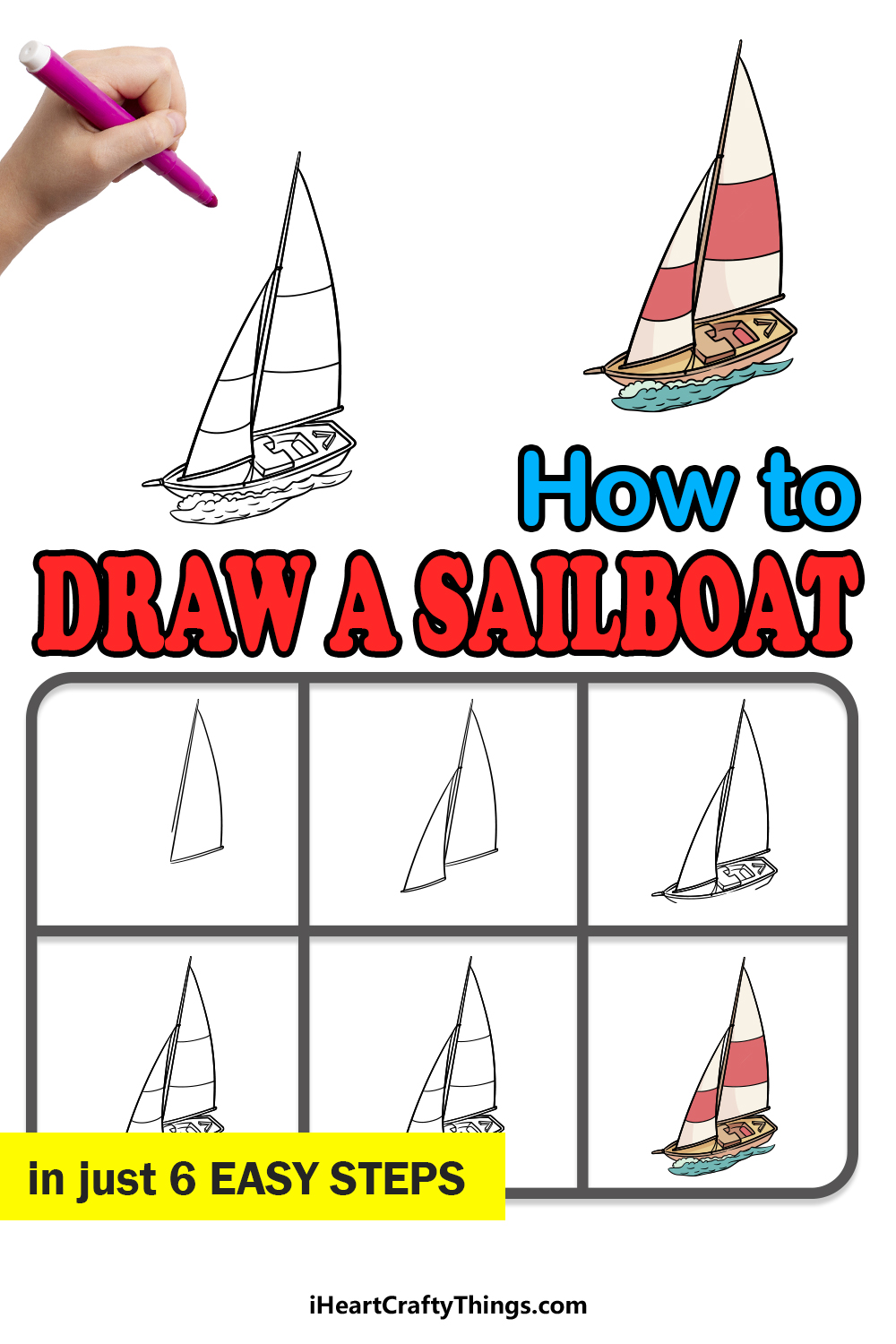
How to Draw Realistic Hair – A Step by Step Guide

How To Draw A Scientist – A Step by Step Guide
© 2024 iHeartCraftyThings

Learn How To Draw a Sailboat: Step-by-Step Guide for Beginners
Alex Morgan
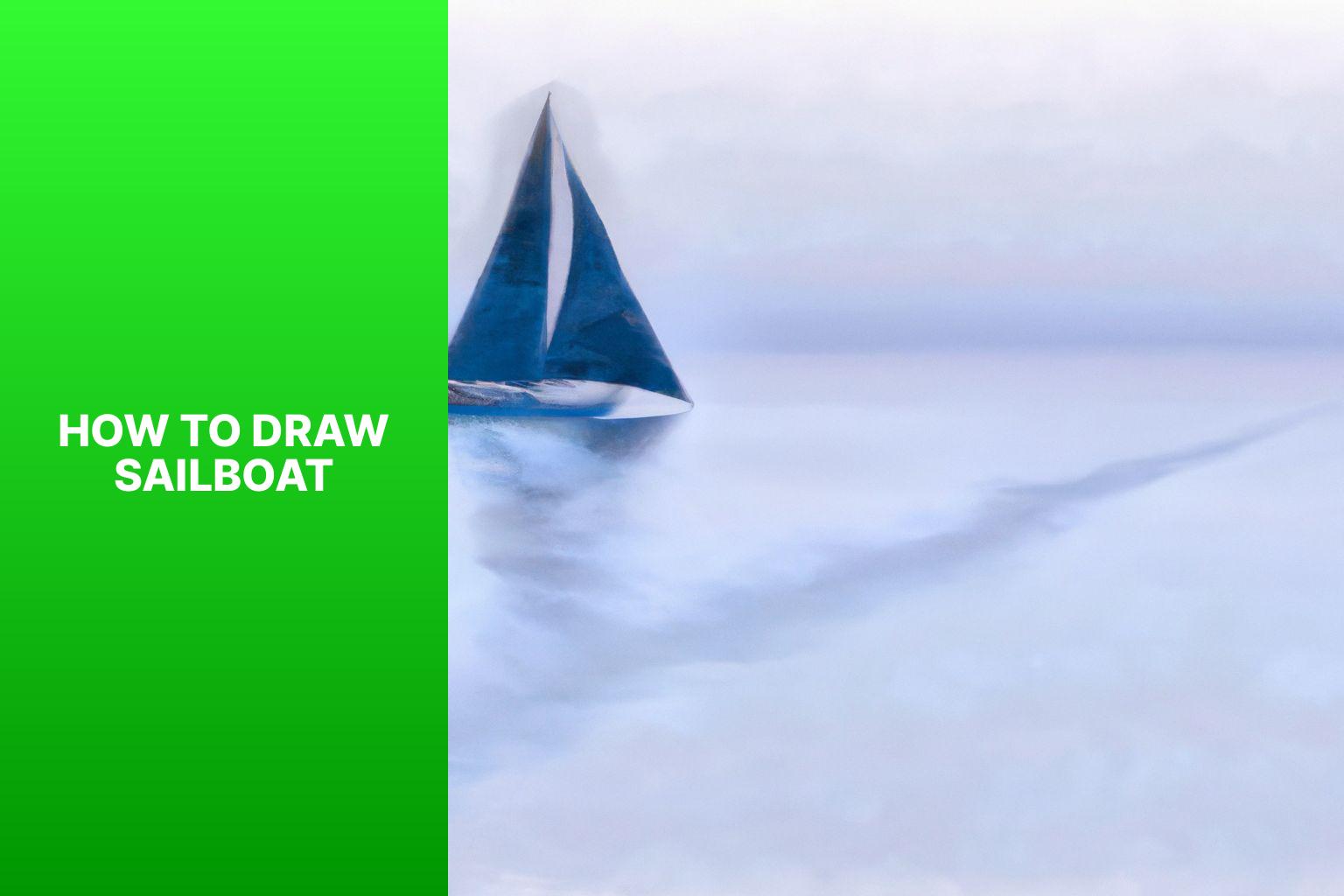
Drawing a sailboat can be a fun and creative activity that allows you to bring a nautical scene to life on paper. Whether you’re a beginner or an experienced artist, learning how to draw a sailboat is a great way to explore your artistic skills. In this article, we will provide you with a step-by-step guide to drawing a sailboat, along with the materials and tools you’ll need. We’ll also share some tips and tricks to enhance your sailboat drawing and answer some frequently asked questions. So grab your pencils, erasers, and paper, and let’s get started on this artistic adventure!
Key Takeaways:
- Pay attention to proportions: Drawing a sailboat requires careful observation of the relative sizes and shapes of its various components to ensure an accurate representation.
- Use light and shadow: Adding shading and highlights to your sailboat drawing can create depth and dimension, making it more realistic and visually appealing.
- Experiment with different pencil grades: Varying the pressure and texture of your pencil strokes can enhance the texture and details of the sailboat, so try using different pencil grades to achieve desired effects.
Materials and Tools Needed
To get started on drawing a sailboat, you’ll need the right materials and tools at hand. From pencils and erasers to drawing paper, rulers, and compasses, this section will guide you through the essential items needed to bring your sailboat creation to life. So, let’s gather everything we need and embark on an artistic journey to capture the beauty of sailboats on paper.
When drawing a sailboat, having the right tools is crucial. One of the most important tools you will need is a pencil . Here are some key points to consider:
1. Choose the right pencil grade: Pencils come in different grades that determine the hardness or softness of the lead. Harder pencils, like 2H or H, produce lighter and finer lines, while softer pencils, like 2B or 4B, create darker and bolder lines.
2. Sharpen your pencil: Keeping your pencil sharp allows for greater precision and control in your lines and shading.
3. Control pressure: Vary the pressure of your pencil on the paper to create different effects, such as light or shadow. Press harder for darker lines and use a lighter touch for lighter lines.
4. Erase and correct: Pencils can be easily erased, so don’t hesitate to make mistakes. Use a good quality eraser to remove unwanted lines or make adjustments as needed.
5. Experiment: Be bold and try different techniques and pencil strokes to add texture and depth to your drawing. Pencil techniques like cross-hatching, shading, and blending can be used to create various effects.
Pro-tip: When starting your sailboat drawing, use a lighter pencil grade for the initial sketch and outline. Gradually build up the details and shading using darker pencil grades for a more realistic effect.
Sorry, but I need more information to complete this task.
3. Drawing Paper
Choosing the right drawing paper is crucial for creating a sailboat masterpiece. The quality of the paper greatly impacts the final outcome of your artwork.
When selecting the perfect drawing paper, there are a few key factors to consider.
First and foremost , pay attention to the weight of the paper. Opting for a heavier weight, such as 90lb or 140lb , ensures durability and the ability to withstand multiple layers of pencil work without tearing or smudging.
Next, think about the texture of the paper. A rough texture adds a touch of realism to elements like the sails and water. On the other hand, if you prefer cleaner lines, go for a smooth or medium texture.
Size is another important consideration. Choose a size that allows you to capture all the intricate details of the sailboat without feeling cramped. Standard sizes like 9×12 inches or 11×14 inches are a good starting point.
Make sure to look for acid-free paper as well. This ensures the longevity of your artwork, preventing yellowing and deterioration over time. With acid-free paper, your sailboat drawing can be preserved for years to come.
Consider the compatibility of the paper with your drawing tools. Whether you’re using graphite pencils or colored pencils, it’s important to ensure that the paper is suitable for your chosen medium. This will prevent smudging or bleeding, allowing you to create a flawless sailboat drawing.
By taking all these factors into account and choosing the right drawing paper, you can enhance your sailboat drawing and create a visually pleasing artwork.
When creating a sailboat drawing, the ruler plays a crucial role in achieving accurate measurements and straight lines. This versatile tool is indispensable throughout the entire drawing process.
The Significance of Using a Ruler in Sailboat Drawing
1. Drawing the hull outline with precise straight lines.
2. Ensuring proportional size by measuring and drawing the mast and boom.
3. Achieving symmetrical and precise sails through the use of straight lines.
4. Adding intricate details such as windows, ropes, and elements with precise measurements.
Incorporating a ruler into these steps not only aids in creating a realistic representation of a sailboat but also improves proficiency with this essential drawing tool.
Fun fact: The origins of the ruler can be traced back to ancient Egypt, approximately 1500 BCE.
When it comes to drawing a sailboat, incorporating a compass is essential for achieving accurate and precise curves and circles. To use a compass effectively, keep these important considerations in mind:
- Opt for a sturdy compass with smooth movement . This will ensure precise measurements.
- Loosen the screw and adjust the compass legs to the desired radius or diameter .
- Ensure the compass is securely fastened to the drawing paper to prevent any unwanted movement while creating circles or curves.
- Mark the center point of the circle or curve using the pointed end of the compass.
- Hold the compass at a comfortable angle and apply steady pressure while rotating it to create the desired curve or circle.
Incorporating a compass effectively will help you achieve symmetrical and well-proportioned shapes in your sailboat drawing.
Before applying the compass to your final drawing, practice on scrap paper to ensure accuracy. Experiment with different compass sizes to create a variety of circle sizes and curves in your artwork. Happy drawing!
Step-by-Step Guide to Drawing a Sailboat
Get ready to set sail on a creative journey with this step-by-step guide to drawing a sailboat. We’ll break down the process into four sub-sections, starting with sketching the hull and gradually progressing to adding the mast, boom, and sails. We’ll add those finishing touches that bring the sailboat to life. By the end of this guide, you’ll have the skills to depict a stunning sailboat on paper, ready to navigate through your artwork. So grab your pencils and let’s embark on this artistic adventure!
Step 1: Sketching the Hull
When starting the process of sketching the hull of a sailboat, the first step is to draw a horizontal line at the top of your paper to represent the waterline. This serves as a guide for positioning the rest of the elements. Next, draw a large U-shaped curve beneath the waterline, which will form the main body of the hull. Inside this U-shape, add a smaller curved line to depict the keel of the sailboat. Moving on to step 4 , extend two straight lines upwards from the curved line to create the stem and stern of the sailboat. Connect the stem and stern with a curved line to complete the outline of the hull. Throughout this process, it is important to use light and smooth strokes to ensure easier adjustments and allow for later detail additions.
Step 2: Adding the Mast and Boom
To incorporate the keywords naturally in the provided text, the “ Step 2: Adding the Mast and Boom ” can be rewritten as follows:
To incorporate the mast and boom into your sailboat drawing, follow these steps:
- Draw a vertical line near the center of the sailboat’s hull to represent the mast.
- Extend a horizontal line from the top of the mast towards the back of the sailboat to represent the boom, the horizontal pole that holds the bottom of the sail.
- Add two diagonal lines from the top of the mast to the front and back of the sailboat to represent the stays, cables that support the mast.
- Draw a smaller vertical line near the front of the sailboat on the boom to represent the gooseneck, the fitting that connects the boom to the mast.
- Add small circles or ovals near the top of the mast to represent the spreaders, horizontal supports that keep the mast steady.
- Enhance the realism by drawing lines representing ropes or rigging that connect the mast to various parts of the sailboat.
By following these steps, you can successfully incorporate the mast and boom into your sailboat drawing. Adjust the proportions as needed to create an accurate representation.
Step 3: Drawing the Sails
To draw the sails of a sailboat, follow these steps:
1. Draw the outline of the sail using light and curved lines. The sail can be triangular or rectangular, depending on the type of sailboat.
2. Add details to the sail by drawing curved lines to represent the seams or edges of the sail.
3. Draw lines or small shapes to represent the grommets or rings that attach the sail to the mast and boom. The attachments will vary based on the sailboat’s design.
4. Use cross-hatching or shading techniques to add depth and dimension to the sail. This will make it look more realistic.
Some suggestions to enhance your sail drawing skills:
1. Practice drawing various types of sails, such as triangular racing sails or traditional square sails. This will help you understand their shapes and details.
2. Experiment with shading techniques to create a realistic look for your sails. Play with light and shadow to add depth and texture.
3. Study reference images of sailboats to understand how sails are positioned and shaped when the boat is in motion. This will help you capture the dynamics of the sails in your drawings.
By following these steps and practicing regularly, you’ll be able to draw realistic and detailed sails for your sailboat illustrations.
Step 4: Adding Detail to the Sailboat
To add detail to the sailboat in your drawing, follow these steps:
1. Add small lines or curves along the hull to represent planks or panels .
2. Draw windows or portholes on the cabin of the sailboat using small circles or rectangles.
3. Include a railing or handrail along the edges of the sailboat by drawing a thin line with small gaps or dots along the sides and back.
4. Add other small details like ropes , cleats , and hatches using short lines or small shapes strategically placed around the sailboat.
5. Shade certain areas of the sailboat to create depth and dimension. Use a slightly darker shade of pencil to add shadows under the railing, along the edges of the hull, and inside the cabin.
Suggestions:
– Take your time when adding details to ensure accuracy and precision in your drawing.
– Refer to reference images or real sailboats for inspiration.
– Experiment with different pencil grades for desired effects. Softer pencils create darker, smoother lines, while harder pencils produce lighter, more defined lines.
By following these steps and paying attention to detail, you can enhance the overall appearance of the sailboat in your drawing.
Tips and Tricks for Drawing a Sailboat
Discover the secrets to mastering the art of drawing a sailboat ! In this section, we’ll uncover valuable tips and tricks that will take your sailboat sketches to new heights . From paying attention to proportions to playing with light and shadow , each sub-section offers unique insights. Get ready to experiment with different pencil grades, adding depth and dimension to your nautical creations. So, grab your pencils and set sail on a creative adventure as we unveil the secrets of creating stunning sailboat drawings.
1. Pay Attention to Proportions
Pay Attention to Proportions when drawing a sailboat. Follow these steps:
1. Start by sketching the basic shape of the hull. Use light, loose lines to establish the size and position on the paper.
2. Add the mast and boom. Consider their height and alignment in relation to the hull . Use a ruler to create straight lines.
3. Draw the sails. Pay attention to their size and shape . Use reference images or observations to capture the curve and folds accurately.
4. Add detail to the sailboat. Include elements such as windows, ropes, and flags. Be mindful of their placement and scale.
The sailboat’s proportions are crucial in creating a realistic and balanced drawing. By accurately representing the size and position of each element, you can achieve a visual harmony and convey the boat’s graceful form.
Sailboats have played a significant role in human exploration and trade throughout history. From ancient civilizations to the Age of Discovery, sailboats have enabled journeys across oceans, connecting cultures and continents. Attention to proportions in sailboat design ensures functional integrity and aesthetic beauty. By understanding and applying the principles of proportion, artists can capture the allure and elegance of these iconic watercraft in their drawings. So, let your imagination set sail as you pay attention to proportions and embark on your artistic journey of drawing a sailboat.
2. Use Light and Shadow
Drawing a sailboat can be a rewarding activity. The use of light and shadow brings the sailboat to life on paper. Understanding how light interacts with objects enables you to create a realistic and engaging drawing experience. Experimenting with different shading techniques and pencil grades enhances the effect of light and shadow in your artwork. The play of light and shadow adds depth, texture, and dimension to your sailboat drawing, making it visually appealing. With practice, you can master the art of using light and shadow to create stunning sailboat drawings. Enjoy the process and let your creativity shine through!
3. Experiment with Different Pencil Grades
Experimenting with different pencil grades can greatly enhance the overall look of your sailboat artwork. Here are steps to help you effectively experiment with different pencil grades:
1. Use a harder pencil grade, like an H or 2H, to lightly sketch the sailboat’s basic shape. This allows for easy adjustments to proportions.
2. Switch to a softer pencil, like a B or 2B, to add definition and darker lines to the sailboat. Outline the hull, mast, and boom to create depth and dimension.
3. Experiment with different pencil grades from H to B to create shading and gradients. Use harder pencils for lighter areas and softer pencils for darker areas. Experiment with different pressures to achieve the desired effect.
4. For texture and details on the sail or other parts of the sailboat, use a softer pencil grade, such as a 4B or 6B. These pencils allow for darker lines and pronounced shading.
Experimenting with different pencil grades will help you create a dynamic and visually appealing sailboat drawing. By varying the hardness and softness of your pencils, you can achieve different levels of shading and detail, making your artwork more vibrant and realistic.
As a historical sidenote, sailboats have a long history and were used for transportation powered by wind. The Egyptians depicted sailboats as early as 3200 BCE. Sailboats played important roles in exploration, trade, and warfare throughout history, particularly during the Age of Discovery. They remain popular for recreation and symbolize adventure and freedom on the open water.
Q: Can I use colored pencils instead of a graphite pencil?
Yes, colored pencils can be used instead of a graphite pencil for drawing a sailboat. Follow these steps:
1. Sketch the outline of the sailboat using a light-colored pencil as the base.
2. Add details and fill in the colors of the boat using colored pencils. Choose colors for each part of the sailboat.
3. Pay attention to proportions and use darker shades of colored pencils for depth and shadows .
4. Experiment with pencil grades for desired effects. Softer pencils create smooth and vibrant colors, while harder ones are for finer details.
A friend tried drawing a sailboat with colored pencils and was amazed by the vibrant colors. The different shades and tones created a visually stunning sailboat that stood out. Colored pencils added a unique and personal touch to the artwork, making it special.
Q: What if I make a mistake?
If you make a mistake while drawing a sailboat, don’t worry! There are a few things you can do to fix it.
1. Assess the mistake: Look at the mistake and understand what went wrong to find the best solution.
2. Erase or correct: Use an eraser for small mistakes and a white gel pen for bigger mistakes.
3. Incorporate the mistake: Sometimes, mistakes can be incorporated into the artwork to create a unique feature.
4. Learn from it: Mistakes are a part of the artistic process. Use them as opportunities to improve your skills.
Remember, making mistakes is normal, especially when learning something new. Embrace them as opportunities for growth in your artwork. Q: What if I make a mistake?
Q: How long does it take to learn how to draw a sailboat?
Learning to draw a sailboat can be rewarding and allows you to express creativity and appreciation for the sea. The time to master this skill varies, but here are steps to consider:
– Start with the basics: Familiarize yourself with materials and tools like pencils, erasers, drawing paper, rulers, and compasses.
– Sketch the hull: Draw the basic shape of the sailboat’s hull, paying attention to proportions and symmetry.
– Add the mast and boom: Draw the vertical mast and horizontal boom that connect to the sail, maintaining correct proportions.
– Draw the sails: Add triangular-shaped sails aligned with the mast and boom.
– Add detail: Enhance the drawing with ropes, flagpoles, and other elements that bring the sailboat to life.
Fact: Creating realistic sailboat drawings takes time and practice, but with dedication and patience, anyone can learn to draw a sailboat beautifully.
Some Facts About How To Draw Sailboat:
- ✅ Drawing a sailboat involves sketching the hull, cabin, mast, sails, and waves. (Source: Our Team)
- ✅ There are various online tutorials available on websites like Art Projects for Kids, wikiHow, Hello Artsy, and i Heart Crafty Things. (Source: Our Team)
- ✅ Drawing a sailboat can be a fun activity for young students and art enthusiasts. (Source: Our Team)
- ✅ Different materials are required for drawing a sailboat, including drawing paper, pencils, crayons or colored pencils, and a black marker (optional). (Source: Our Team)
- ✅ Adding color to the sailboat drawing can help bring it to life and create a more visually appealing artwork. (Source: Our Team)
Frequently Asked Questions
Faqs for how to draw a sailboat:.
Q: What materials do I need to draw a sailboat? A: To draw a sailboat, you will need basic drawing tools such as a pencil, drawing paper, and coloring tools if desired.
Q: Are there any specific drawing steps to follow? A: Yes, there are specific steps to follow when drawing a sailboat. The steps typically include drawing the hull, cabin, mast, sails, and waves. Detailed instructions can be found in the provided sources.
Q: How long does it take to draw a sailboat? A: The time needed to draw a sailboat may vary depending on individual drawing speed and complexity of the artwork. Some sources suggest it can take around 30 minutes, but it may take longer if additional details or nautical crafts are included.
Q: Can I use different colors to enhance my sailboat drawing? A: Yes, you can use different colors to enhance your sailboat drawing. Experiment with crayons, colored pencils, acrylic paints, or other coloring tools to bring your drawing to life. The choice of colors is highly customizable and can be tailored to your preferences.
Q: Can I find printable resources for drawing a sailboat? A: Yes, some of the provided sources offer printable resources such as coloring pages and PDF tutorials that can be downloaded. These resources can provide additional guidance and make the drawing process more convenient.
Q: Can I personalize my sailboat drawing with additional details? A: Absolutely! You can personalize your sailboat drawing by adding your own details such as people, patterns, background elements like islands or sea creatures, and more. Let your creativity flow and make your sailboat drawing unique.
About the author
Leave a Reply Cancel reply
Your email address will not be published. Required fields are marked *
Save my name, email, and website in this browser for the next time I comment.
Latest posts

The history of sailing – from ancient times to modern adventures
History of Sailing Sailing is a time-honored tradition that has evolved over millennia, from its humble beginnings as a means of transportation to a beloved modern-day recreational activity. The history of sailing is a fascinating journey that spans cultures and centuries, rich in innovation and adventure. In this article, we’ll explore the remarkable evolution of…

Sailing Solo: Adventures and Challenges of Single-Handed Sailing
Solo Sailing Sailing has always been a pursuit of freedom, adventure, and self-discovery. While sailing with a crew is a fantastic experience, there’s a unique allure to sailing solo – just you, the wind, and the open sea. Single-handed sailing, as it’s often called, is a journey of self-reliance, resilience, and the ultimate test of…

Sustainable Sailing: Eco-Friendly Practices on the boat
Eco Friendly Sailing Sailing is an exhilarating and timeless way to explore the beauty of the open water, but it’s important to remember that our oceans and environment need our protection. Sustainable sailing, which involves eco-friendly practices and mindful decision-making, allows sailors to enjoy their adventures while minimizing their impact on the environment. In this…
Advertisement
How to Draw Sailboats in 6 Steps
- Share Content on Facebook
- Share Content on LinkedIn
- Share Content on Flipboard
- Share Content on Reddit
- Share Content via Email
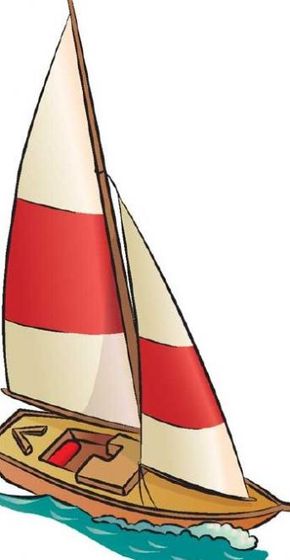
Sailboats travel far and wide, exploring the ocean and seeking out tropical locales. Use our step-by-step instructions to create your own sailboat scenes.
In this article, we'll show you how to draw the above sailboat. Either draw it freehand while looking at your computer monitor or print out this page to get a closer look at each step.
Follow the red lines in each illustration to learn exactly what to draw in that step. The lines drawn in previous steps are shown in gray. Here, we'll show you an illustration of each step and then give you a description of how to draw it.
Are you ready to get started? Head over to the next page for the first step.
- Draw the Sails and Hull
- Add the Seating Area
- Draw the Mast and Deck Details
- Add Details to the Sails
- Draw the Water
- Add the Final Touches
1. Draw the Sails and Hull
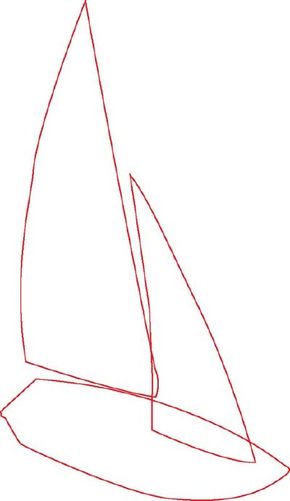
Start the sailboat with two big curved triangles for the sails. Add a pointed shape for the hull.
On the next page, we'll learn how to draw the seating area.
2. Add the Seating Area
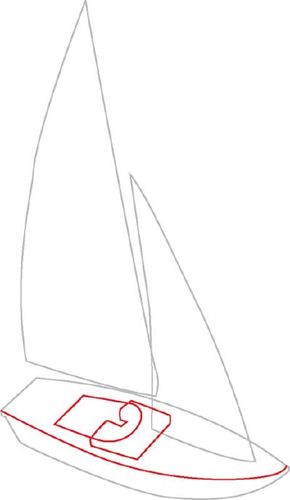
Draw a curved line to form the side of the hull. Sketch a rectangle with a rounded end for the seating area. Add a fat bracket shape on top of it.
Head over to the next page, and we'll find out how to draw the mast and deck.
3. Draw the Mast and Deck Details
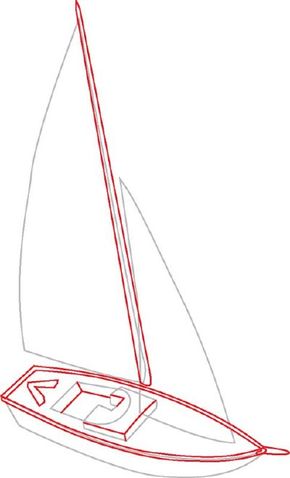
Draw the mast between the sails. Add edge lines following the hull. Sketch a V-shape bar to create deck detail, and add lines for depth in the seating area. Draw a small post on the front of the boat.
We'll work on adding detail to the sails on the next page.
4. Add Details to the Sails
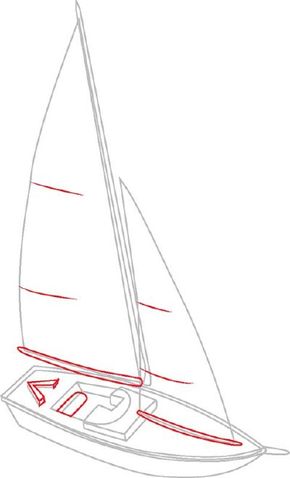
Add rectangular crossbars at the bottom of both sails. Draw detail lines on the V shape and in the seating space. Add detail lines to each sail.
What good is a boat without water? Check out the next page, and we'll add some waves for out sailboat.
5. Draw the Water

Draw wavy lines under the boat for the water.
We're almost done! Head over to the next page, and we'll add the final touches.
6. Add the Final Touches
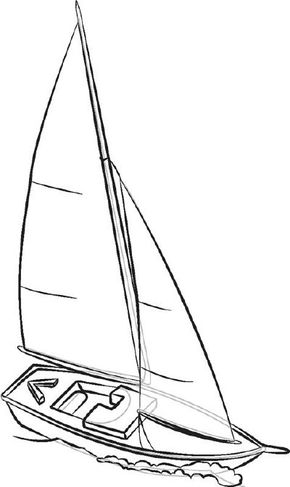
Use a felt-tip pen to trace the lines you want to keep. Erase any extra pencil lines.
Explore the ocean's depths with our next drawing project. Learn to draw a submarine.
See all How to Draw articles .
Please copy/paste the following text to properly cite this HowStuffWorks.com article:
- Skip to primary navigation
- Skip to main content
- Skip to primary sidebar

How To Draw a Sailboat
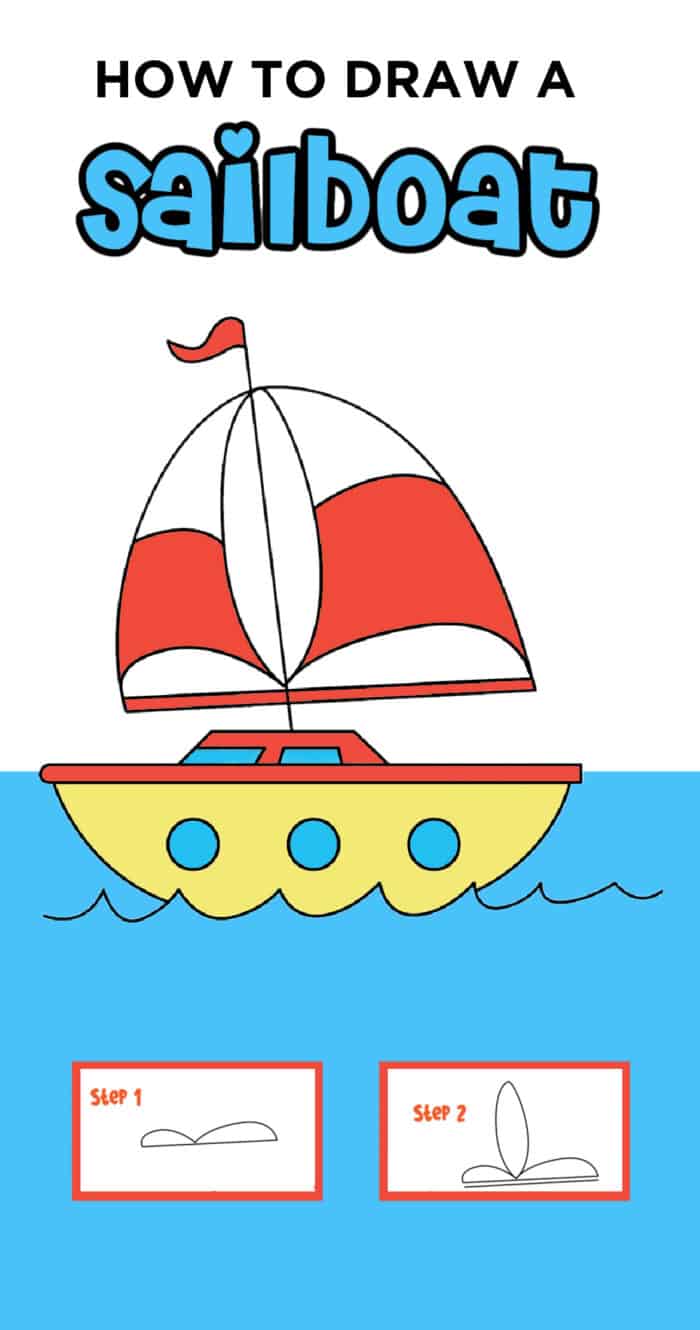
Learn the art of drawing a sailboat with easy step-by-step instructions. Sail away into creativity and master the seas on paper!
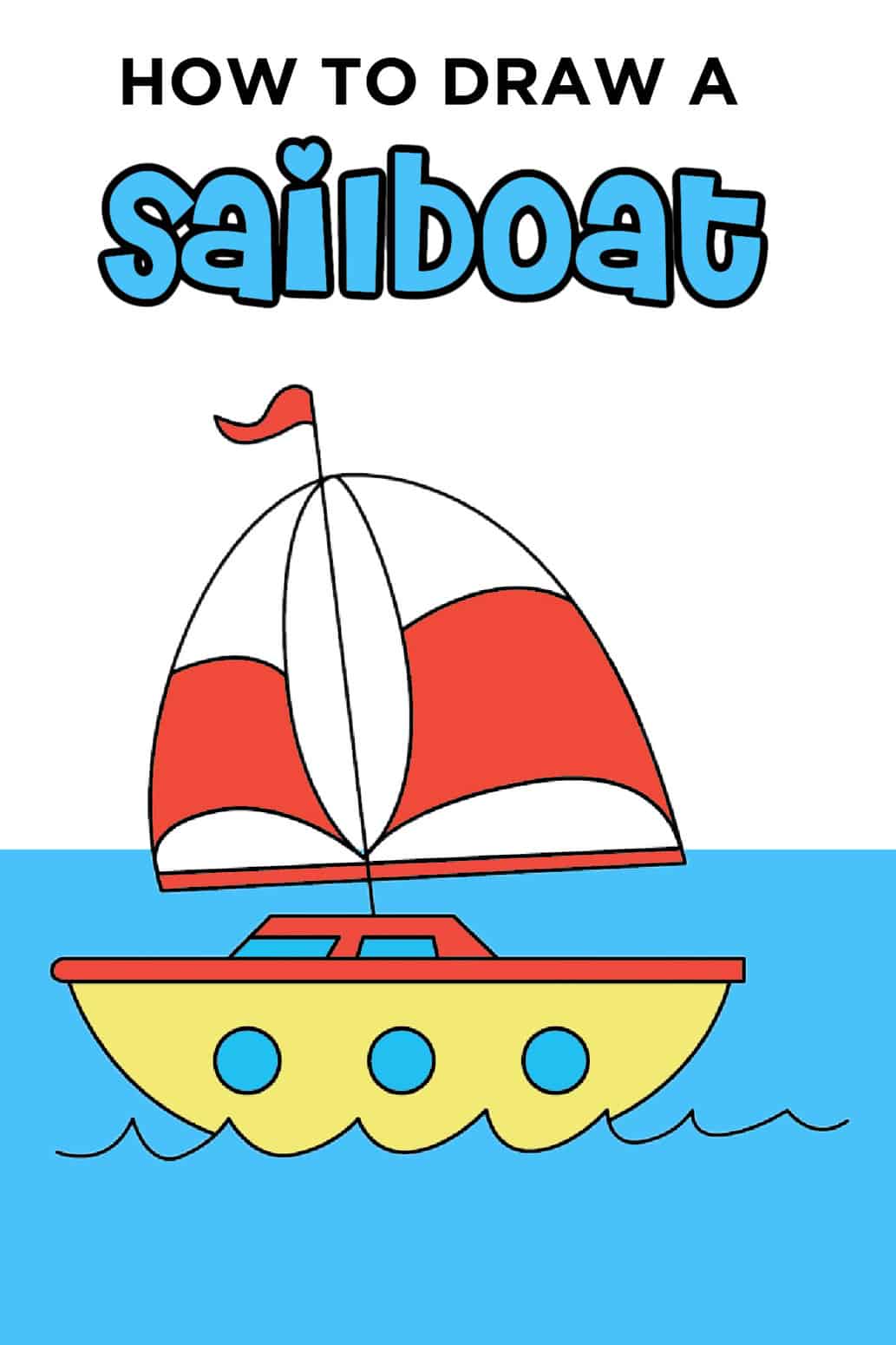
Ahoy, young artists! Embark on a thrilling artistic journey as we unveil a step-by-step guide on how to draw a sailboat.
Join us on a creative voyage, perfect for kids of all ages, as we navigate through simple and fun techniques to bring a charming sailboat to life on paper. So, grab your pencils and set sail into the world of imagination and artistry!
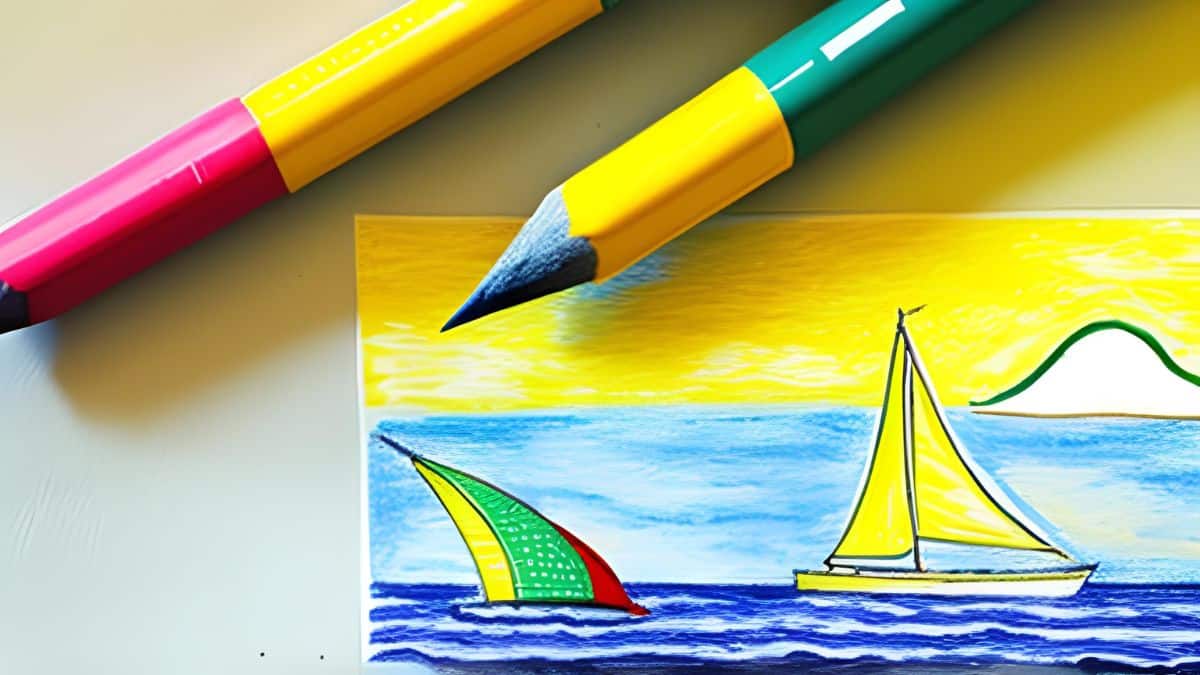
Want to save this project?
Enter your email below, and then we'll send it straight to your inbox. Plus get awesome new projects from us each week.
Sailboat Drawing
Drawing a sailboat can be super fun! It's like going on an exciting adventure with your art. First, imagine your perfect sailing ship – fast and sleek or a cool pirate ship. Then, you use a pencil to draw it on paper.
As you sketch the boat's shape and sails, you feel the joy of creating something amazing. It's like being the captain of your own artistic journey, where every stroke of the pencil guides you to a masterpiece.
But the fun doesn't stop there! You can make your sailboat unique. Add bright colors to the sails and create a beautiful ocean background with waves.
Don't forget the details that make it special. Draw friendly sea creatures or brave sailors on board. Your sailboat could be on a daring treasure hunt!
There are no right or wrong ways to draw a sailboat. It's all about letting your imagination go wild and having fun. Try different styles and art materials like watercolors or colored pencils.
Drawing a sail boat lets you explore your creativity and express yourself.
Check out these other Boat Crafts!
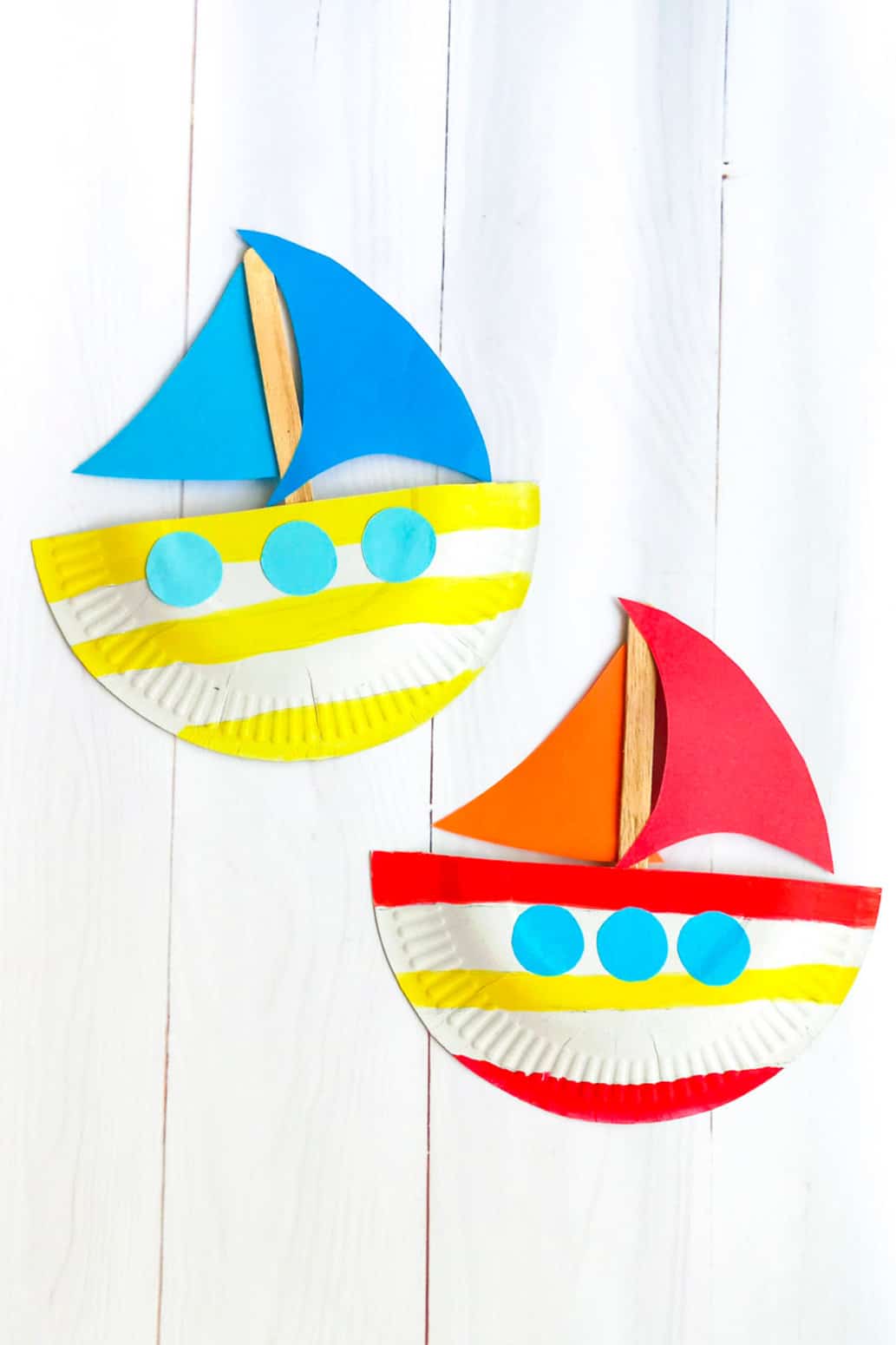
Paper Plate Boat
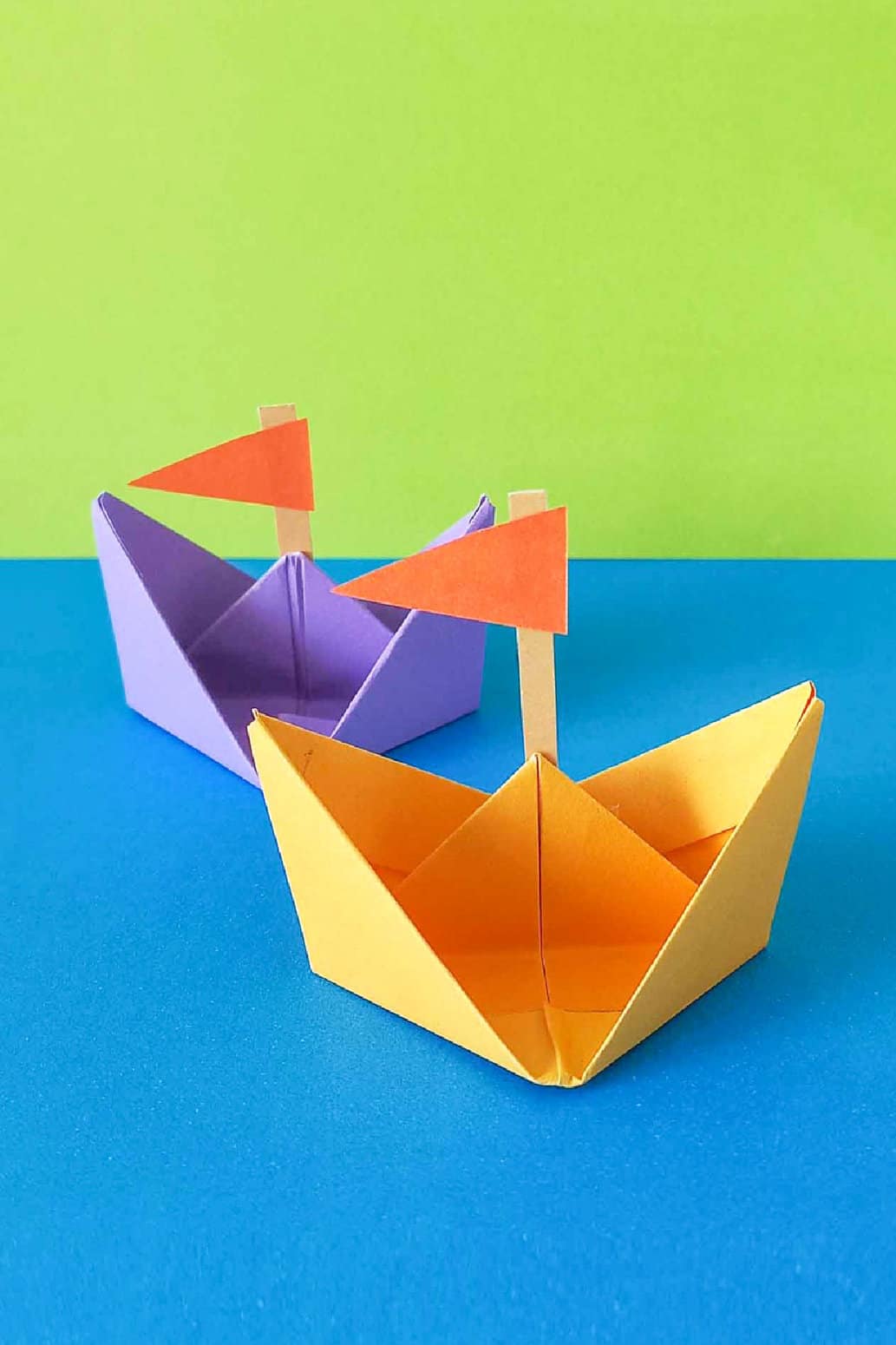
Origami Boat
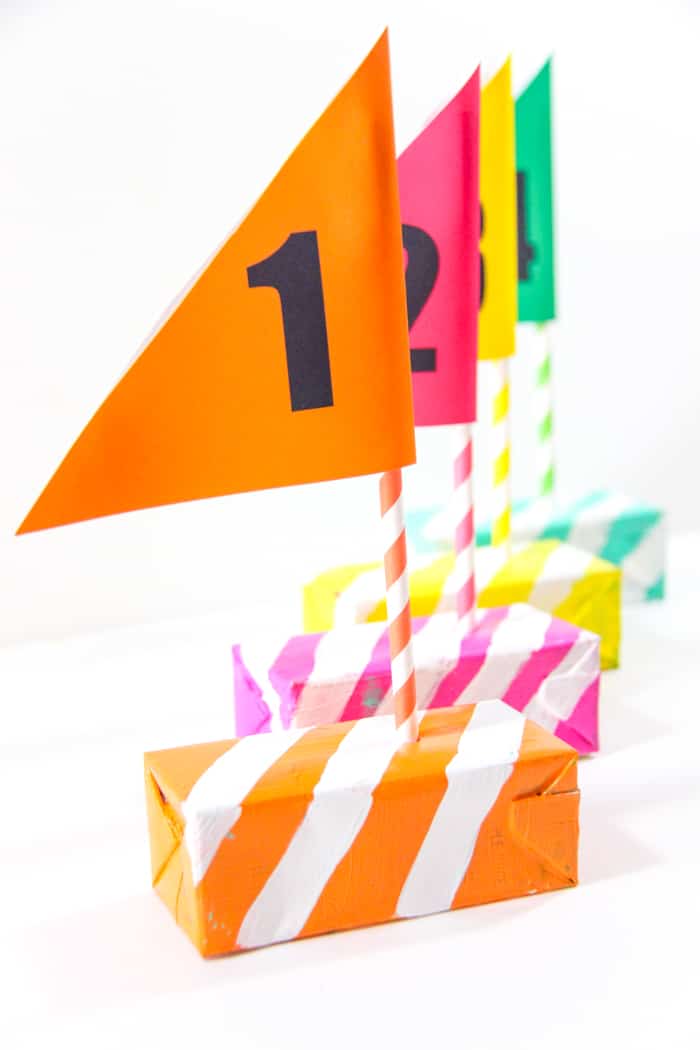
Juice Box Boat Craft
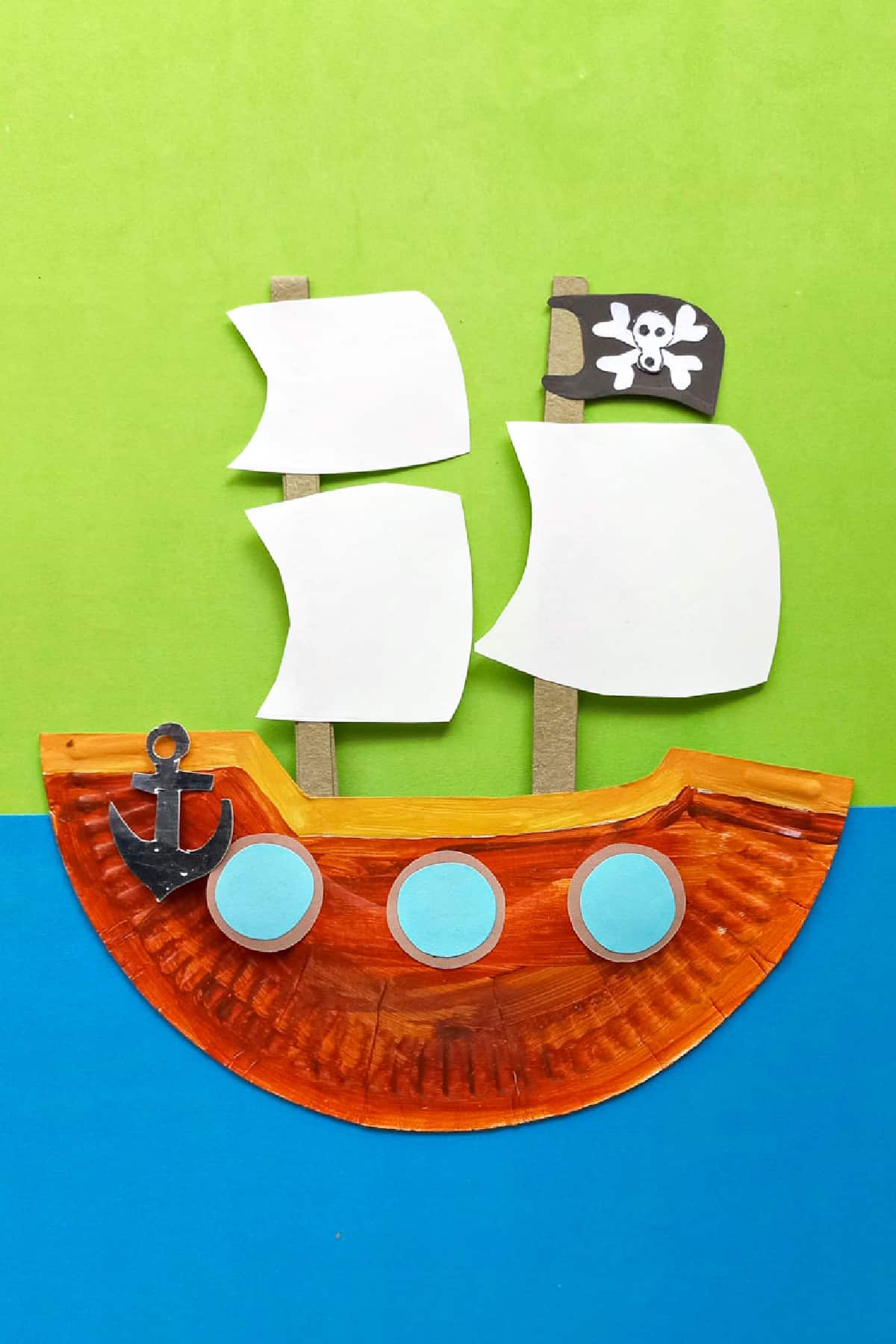
Pirate Ship Craft
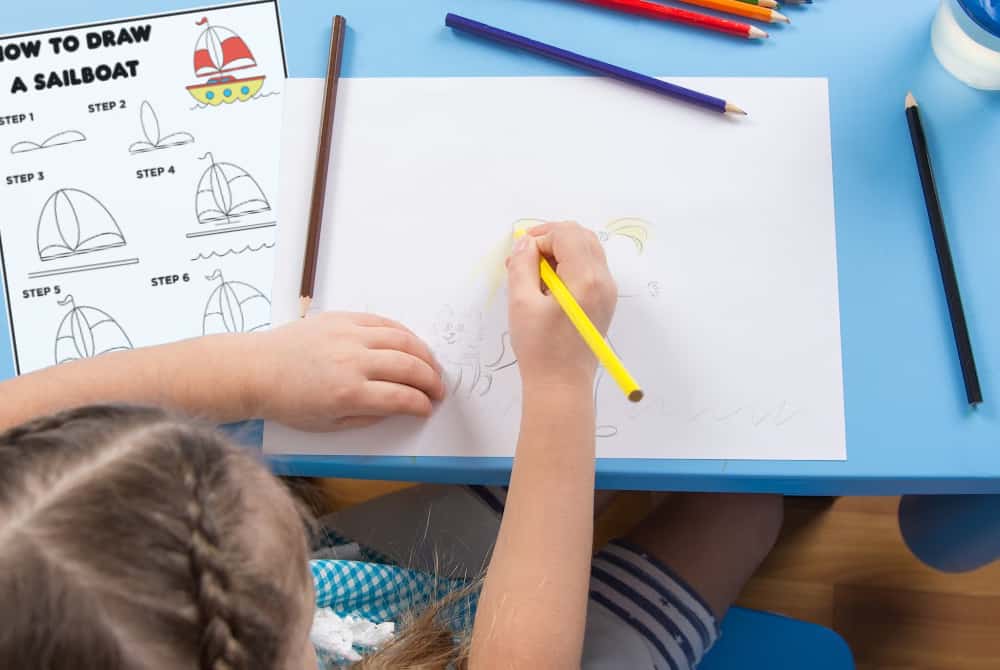
Benefits of Drawing
Drawing is a fantastic activity for kids that comes with many benefits. When you draw, you get to show off your creative ideas and feelings. It helps you improve your small hand movements, like holding a pencil or doing other tasks.
Drawing also makes your eyes and hands work together better. When you draw things around you, it helps you notice details and shapes more. This allows your brain to become better at solving problems.
Drawing can also help you feel better emotionally. It lets you express your feelings in a safe and fun way. You feel proud and more confident when you practice drawing and get better at it. It's like solving a puzzle!
When you draw, you need to focus and be patient. It teaches you how to keep trying even if something is tricky. Drawing can also teach you about different cultures and history. You can draw things from different places and times, and it helps you learn more about the world.
Drawing can be a social thing, too. You can draw with your friends and share your ideas. It's a great way to connect with others.
So, have fun drawing! It's not just about making pretty pictures – it's about growing your skills, understanding yourself, and having a great time with your friends! Grab your art supplies and start drawing.
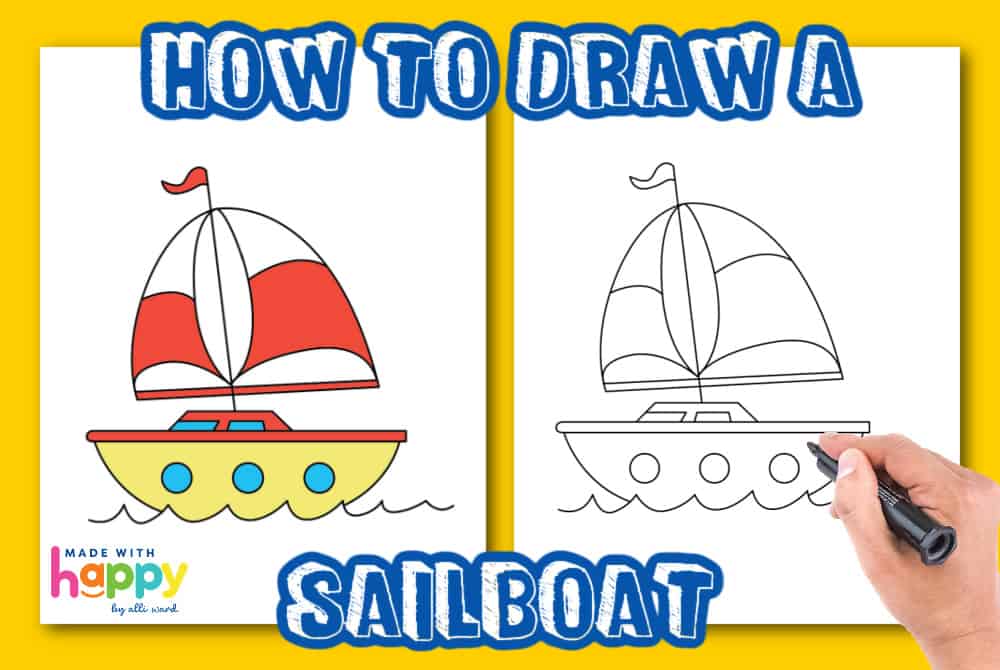
Drawing of Sailboat Easy
Learning to draw is always fun for drawers of any age. We love breaking down each of the drawings into a step-by-step guide. I also think having the printable drawing guide helps in making the easy drawings come to life.
If you love drawing tutorials as much as we do, then you will not want to miss some of our other fun drawing lessons .
- Butterfly Drawing
- Rose Drawing
- Dragon Drawing
- Frog Drawing
- Crown Drawing
Before you start drawing, we also want to make sure you have the right tools. Here are the drawing paper , and drawing pencils that we like to use.
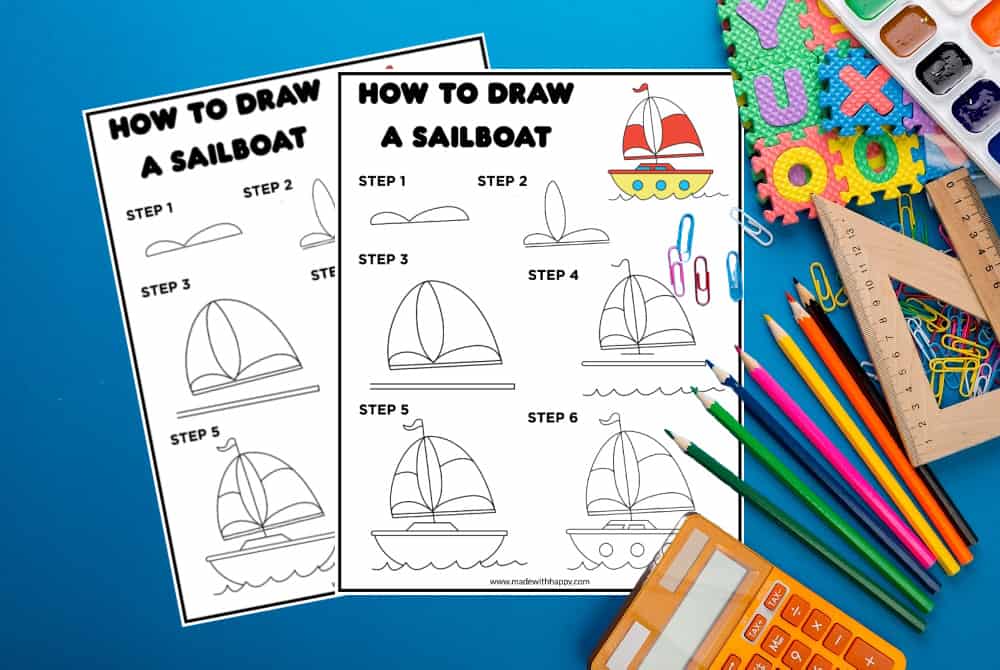
The drawing is a cartoon sailboat and gives a basic idea of a sailboat sketch. You can later add more details to it and color it. Your kids will have a few good practice times, and soon they’ll be drawing boats like a pro!
Get your free printable tutorial now, and help your kids grow artistically! Grab a sheet of paper and a pencil and let's start drawing.
Drawing the Sail
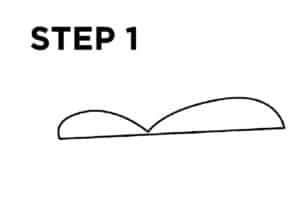
The first step is to the bottom frame of the sail. Draw a straight line as the bottom of the sail. Then a curved line like a wide m shape with the left curved line slightly smaller than the second.
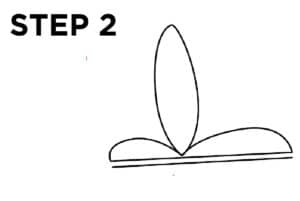
Next, draw a leaf shape in the v portion from the previous step. Add a straight line under the bottom of the sail.
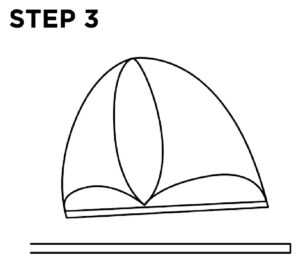
Next step, draw a curved line from the bottom line around the outside up to the point of the leaf shape. Draw one on each side of the sails creating a full shape of the sail. Then draw two horizontal lines under the sail as the top of the boat.
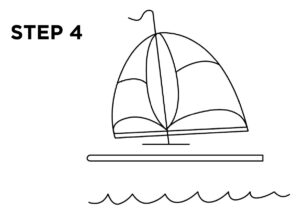
In the next step, draw a line through the bottom of the sail through the leaf shape, and out the top. Draw a small curvy line off the top and a small horizontal line between the top of the boat and the sail. Add a small curved line on both the front sail and back sail to add stripes to the sail. Then draw wavy lines under the top of the boat as the water.
Drawing the Body of the Sailboat
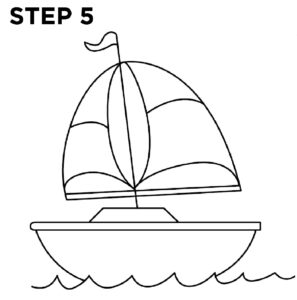
Draw a curved line as the bottom of the boat from each side of the boat down into the water. Then draw two slightly diagonal lines from the small horizontal line between the top of the boat and the sail down towards the top of the boat body creating a trapezoid shape as the top of the boat or helm. Draw a small curved line to complete the flag at the top of the sailboat.
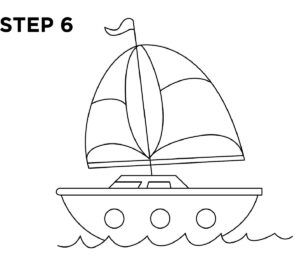
Lastly, add the final details of the boat. Small details like three small circles on the boat body. Add two rectangles inside the helm.
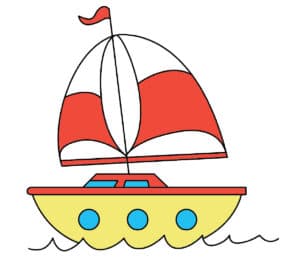
The last step is to go over your drawing with a dark marker and then color in your sailboat. I love the idea of using basic colors.
Happy Drawing!
We highlighted this Boat Drawing along with some other fun kid's crafts in our Summer Crafts along with our 101+ Easy Craft Ideas for kids .
You also do not want to miss our 101+ Coloring Pages and 101+ Printables full of Crafts and Coloring Pages.

Other Fun Summer Crafts For Kids
- Popsicle Stick Bird Feeder
- Paper Weaving
- Popsicle Tissue Paper Craft
- Cactus Craft
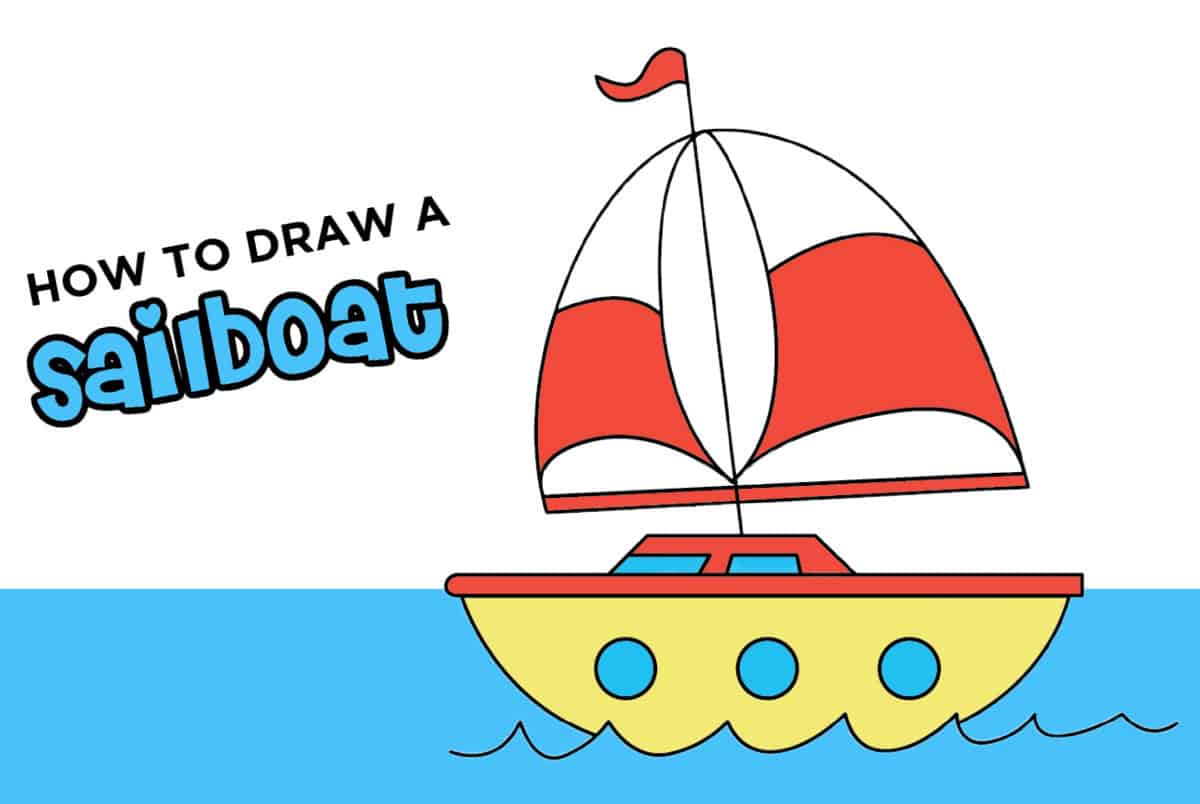
Download Sailboat Simple Steps Tutorial
Enter your email address in the form below and you'll be taken directly to the Sailing Boat Drawing Tutorial pdf file.
*For Personal Use Only
How to Draw a Sailboat
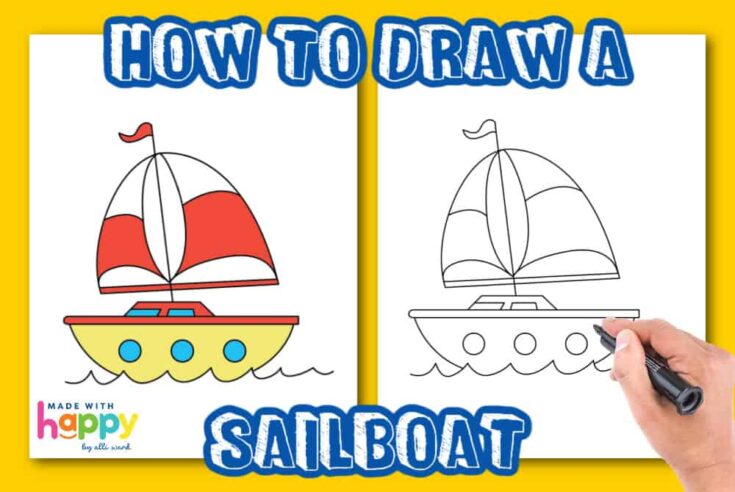
- Sailboat Drawing Tutorial
- Drawing Pencils
Instructions
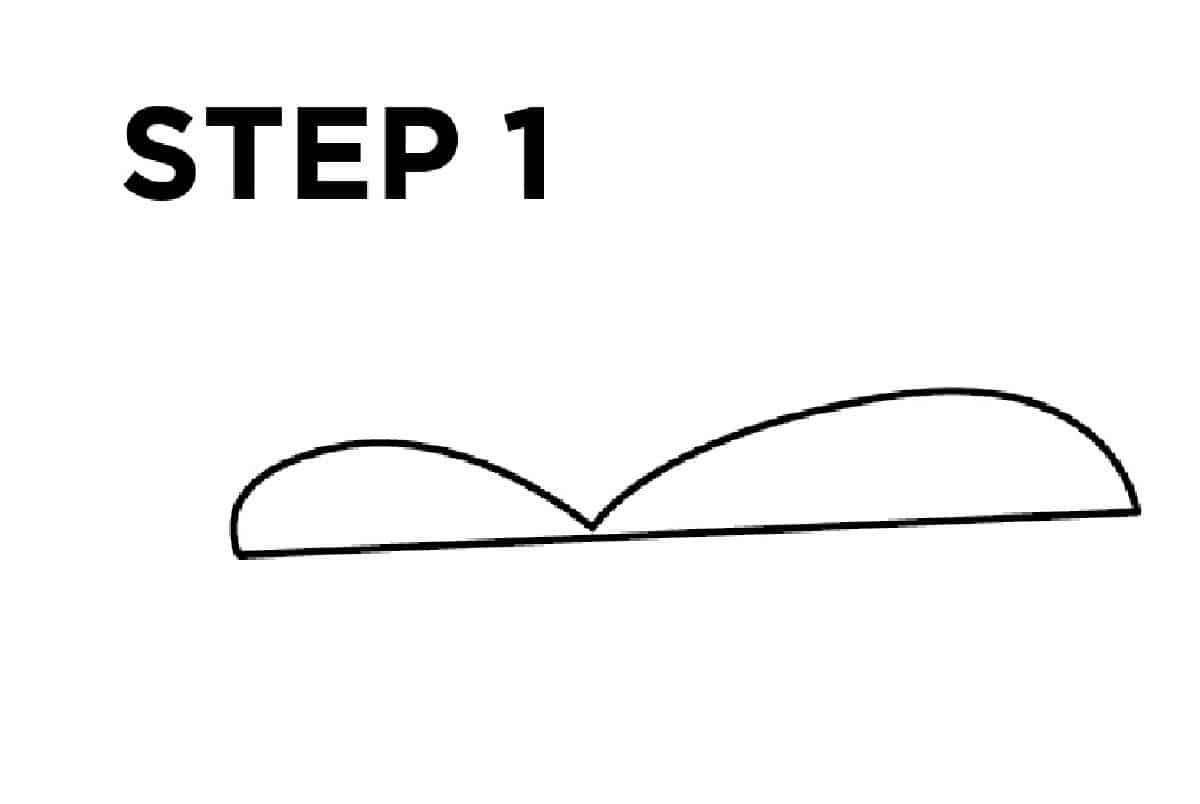
CONNECT WITH MADE WITH HAPPY!
Be sure to follow me on social media, so you never miss a post!
Facebook | Twitter | Youtube | Pinterest | Instagram
Looking for crafts to keep your child busy? Sign up for my 5 Ridiculous HAPPY Activities in under 30 minutes for your kids delivered directly to your inbox!
Find and shop my favorite products on my Amazon storefront here!
HOW TO DRAW A SAILBOAT
Pin it to your diy board on pinterest.
FOLLOW MADE WITH HAPPY ON PINTEREST FOR ALL THINGS HAPPY!
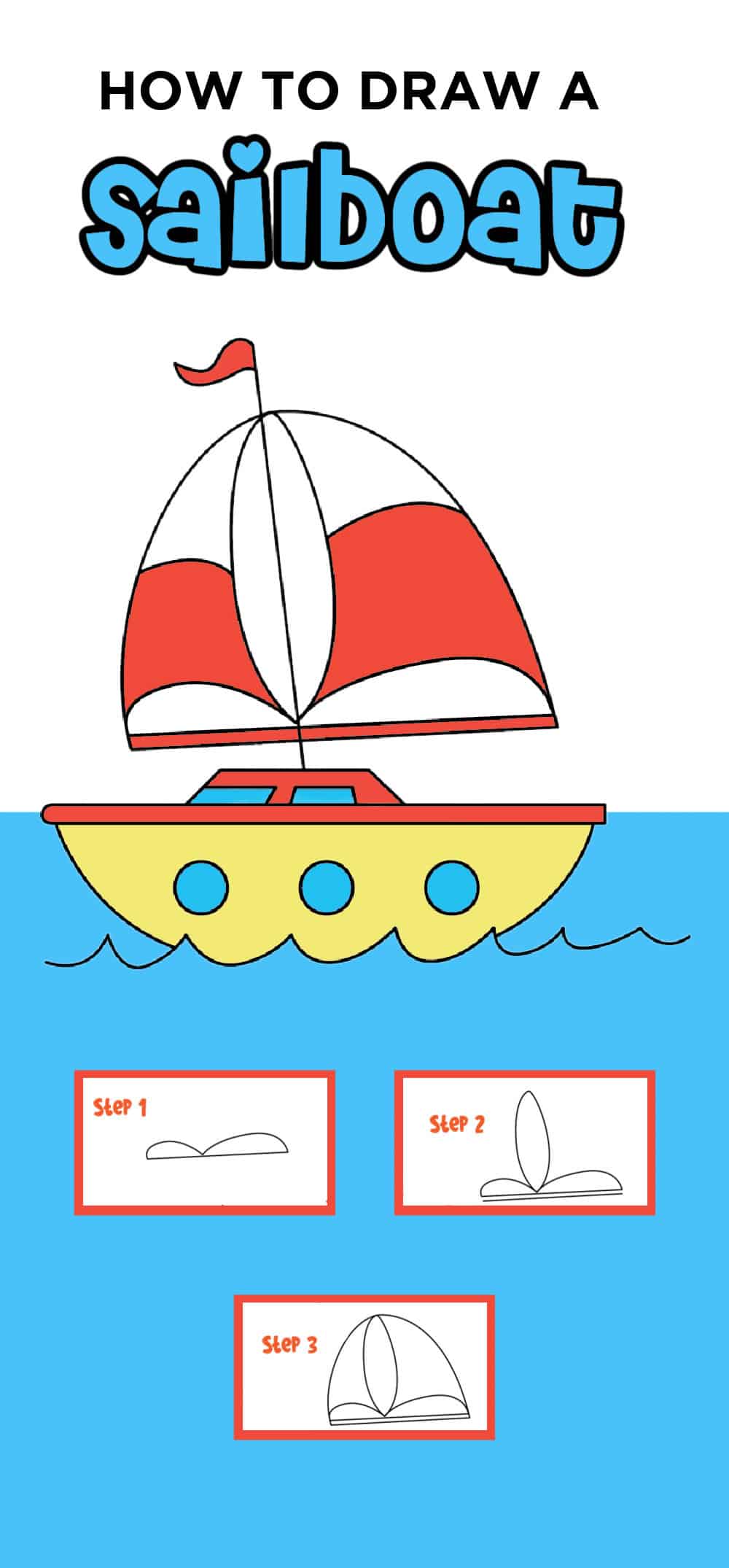
More How To Draw Tutorials

Discover a world of creativity and joy with Alli Ward, the creative mind behind Made with Happy. From DIY crafts to delicious recipes, Alli brings happiness to every project!

How to Draw a Sailboat

Skill Level : 1 Beginner , 2 Intermediate
Medium : Pencil Drawing
Subject : Seascapes , Transport
Tutor : Nolan Clark
Class Length : 2 hours 10 minutes
Avg Rating : No Ratings Yet
Silver Level or Higher Class
Class Description
- Read Class Reviews
In this lesson we will draw a sailing boat.
During the class you will learn:
1) How to draw clouds 2) How to draw the sails so they look like they have various amounts of wind 3) How to draw reflections in the water 4) How to show the land in the distance 5) and much more...
Latest Reviews
Unlock the follow along class here, short class video.
Class Tutorial

In this tutorial we will draw a sailboat. This is the reference photo I will be working from.
Drawing the Sky

Our sailboat reference photo doesn't have nice clouds in it so I have found this photo which does have nice clouds.
We will use our artistic license to add clouds similar to these into our drawing. That should add extra drama and interest to the scene.

Start off by covering a spare piece of paper with graphite.
We will use this and a cloth to draw with.

We don't want to lose the horizon so we mask it off.

Now rub the cloth over the graphite paper, then onto your drawing to draw the clouds.
In a circular motion rub the shadows of the clouds onto the paper.

What I am trying to do is create the gradual shadings formed by the clouds.
To ensure I don't loose the shape of the boat I use an eraser to keep the edges of the sails defined.
The clouds give us the contrast we need for the white sails to be visible so don't be shy with the contrast you add to the clouds.
Drawing the Sails

Now we can move over to the sails.
Each sail has a different shading because of its shape so you need to carefully look at how the light reflects off of each sail.
This one here is round so it has a gradual shading.

The one behind it is also round so will also get that gradual shading.
This time however the first sail is casting a shadow on it so the tonal values of these shadings are different.
To draw these tonal values and shadings correctly vary the pressure you apply to the pencil as well as use harder and softer pencils.

This sail is full of creases, just suggest these creases by creating a series of contrasting lines.
Look very carefully at the direction of these lines through as they follow the shape of the sail.
Do the same with the other sails as well.

Now we can start to add the detail to the sails.
For this use a very sharp pencil or a mechanical pencil to add in all the rigging and to suggest the stitching work on each sail.

To ensure you draw the masts accurately use a ruler to draw the outside edges. Then color in the insides.
To show the mast is round darken the right hand edge on each mast.
Now we can gently remove the masking tape in order to draw the water.
Drawing the Water

There is a dark edge to the horizon so I use the ruler to establish the edge of the boat so I don't lose it's shape.

Now use your cloth and the graphite paper to lay down a basic tonal value on the water.

Erase the ripples on the water using a kneaded eraser.
To show perspective, make the ripples in the distance short and close to each other and the nearby ripples large and further apart.

The reflections are broken vertical lines so put in the dark vertical lines using the cloth first.
Then squiggle out the lighter reflections.
I have also used the pencil to squiggle a few extra contrasts here and there which completes the water.
Drawing the Boat

Now shade in the shape of the boat.

And use a dark pencil to suggest the people and detail on the boat.
Don't draw fine detail here. Suggestions and basic shapes are good enough. Your brain will imagine the rest of the detail when looking at the completed artwork.

This is what the final sailboat drawing looks like:
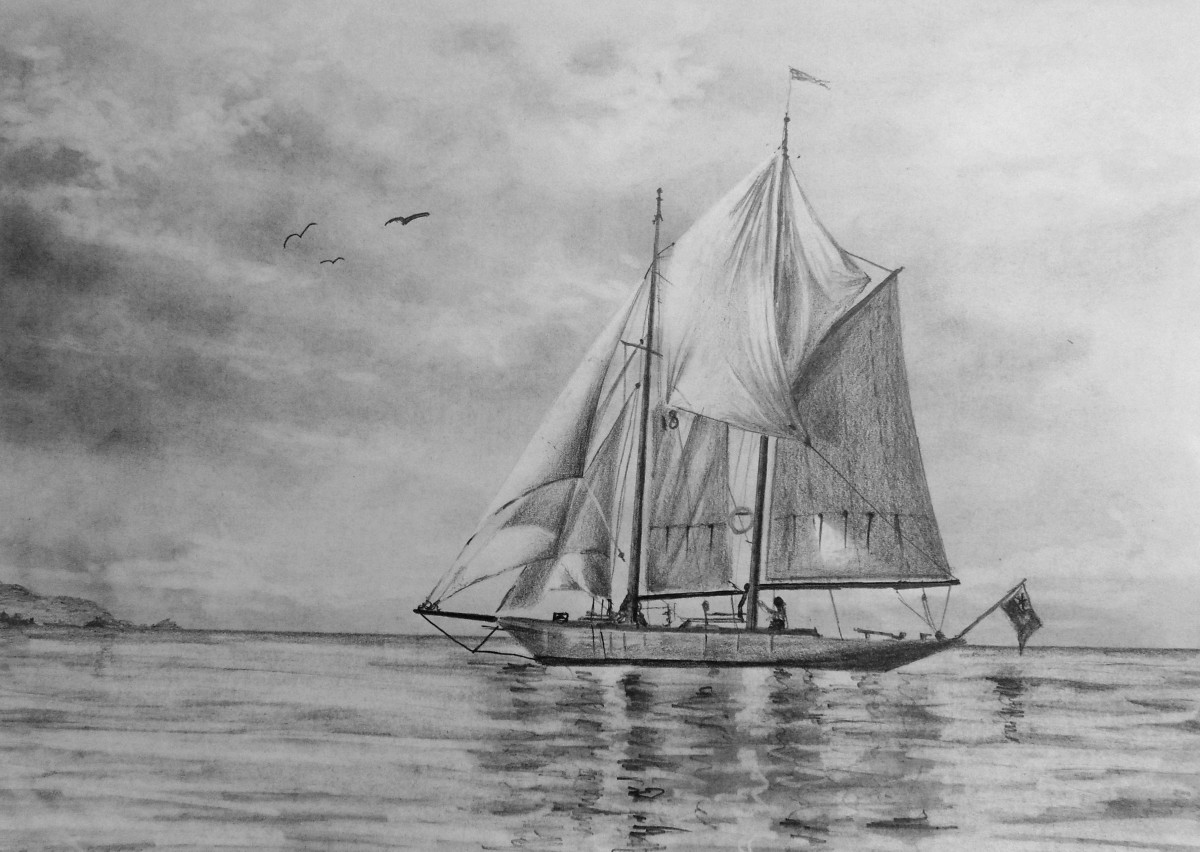
Enjoying This Tutorial?

About Nolan Clark
Read more about Nolan Clark

Follow Us on :
Copyright © · Paint Basket TV · All Rights Reserved
As an Amazon Associate, I earn from qualifying purchases.
Pin It on Pinterest
- PRO Courses Guides New Tech Help Pro Expert Videos About wikiHow Pro Upgrade Sign In
- EDIT Edit this Article
- EXPLORE Tech Help Pro About Us Random Article Quizzes Request a New Article Community Dashboard This Or That Game Popular Categories Arts and Entertainment Artwork Books Movies Computers and Electronics Computers Phone Skills Technology Hacks Health Men's Health Mental Health Women's Health Relationships Dating Love Relationship Issues Hobbies and Crafts Crafts Drawing Games Education & Communication Communication Skills Personal Development Studying Personal Care and Style Fashion Hair Care Personal Hygiene Youth Personal Care School Stuff Dating All Categories Arts and Entertainment Finance and Business Home and Garden Relationship Quizzes Cars & Other Vehicles Food and Entertaining Personal Care and Style Sports and Fitness Computers and Electronics Health Pets and Animals Travel Education & Communication Hobbies and Crafts Philosophy and Religion Work World Family Life Holidays and Traditions Relationships Youth
- Browse Articles
- Learn Something New
- Quizzes Hot
- This Or That Game
- Train Your Brain
- Explore More
- Support wikiHow
- About wikiHow
- Log in / Sign up
- Hobbies and Crafts
4 Easy Ways to Draw a Boat
Last Updated: April 6, 2023
- Traditional Ship
- Wooden Boat
Things You'll Need
This article was co-authored by Kelly Medford . Kelly Medford is an American painter based in Rome, Italy. She studied classical painting, drawing and printmaking both in the U.S. and in Italy. She works primarily en plein air on the streets of Rome, and also travels for private international collectors on commission. She founded Sketching Rome Tours in 2012 where she teaches sketchbook journaling to visitors of Rome. Kelly is a graduate of the Florence Academy of Art. This article has been viewed 369,000 times.
Want to go sailing but don't have a boat? Don't sweat over it. Chill out and follow this tutorial to learn how to draw a kayak, draw a yacht, draw a rowboat, and draw a sailing ship. If you want to draw a boat, draw an imaginary one or copy a picture from a book or online image.
Note: follow the red line for each step.
Things You Should Know
- Start by drawing the outline of the boat using basic shapes and guidelines.
- Add details to your drawing, like sails, masts, and siding.
- Clean up your drawing by erasing any guidelines.
Drawing a Sailboat

Drawing a Kayak

Drawing a Traditional Ship

Drawing a Realistic Style Wooden Boat

Community Q&A
- Learning to draw is really about learning to see. Study boats each day and draw them until you can get them as close as you can to the real objects you're observing. Thanks Helpful 1 Not Helpful 1
- To get better at drawing, make sure to practice blind contour drawings observing objects and people. Do not worry about the results, as the idea is to train your eye to slow down and to work in tandem with your hand. Thanks Helpful 0 Not Helpful 0

- Sharp Sketching Pencil
- Pencil sharpener
- Colored pencils, crayons, markers or watercolors
You Might Also Like

About This Article

One way to draw a boat is by sketching a sailboat. Start by making the outline of a trapezoid to sketch the main body of the boat. Then, draw a smaller trapezoid in the middle of the boat, with a long line running perpendicular to the body of the boat. Next, draw a right triangle off of the right side of the line, and another, slightly smaller triangle off of the right side of the line. You can make the body of the boat 3-dimensional if you’d like. Once you have the basic shapes, trace the outline and erase the extra pencil marks before filling it in with color. If you want to learn how to draw other kinds of boats, such as a canoe or kayak, keep reading the article! Did this summary help you? Yes No
- Send fan mail to authors

Reader Success Stories
Annabella Schafer
Jan 31, 2017
Did this article help you?

Mar 28, 2016
Shanmuka G.
Feb 20, 2020
Larry Froseth
Oct 15, 2016
Nov 3, 2016

Featured Articles

Trending Articles

Watch Articles

- Terms of Use
- Privacy Policy
- Do Not Sell or Share My Info
- Not Selling Info
wikiHow Tech Help Pro:
Develop the tech skills you need for work and life
- Images home
- Editorial home
- Editorial video
- Premium collections
- Entertainment
- Premium images
AI image generator
- Curated collections
- Animals/Wildlife
- Backgrounds/Textures
- Beauty/Fashion
- Buildings/Landmarks
- Business/Finance
- Celebrities
- Food and Drink
- Healthcare/Medical
- Illustrations/Clip-Art
- Miscellaneous
- Parks/Outdoor
- Signs/Symbols
- Sports/Recreation
- Transportation
- All categories
- Shutterstock Select
- Shutterstock Elements
- Health Care
- Sound effects
PremiumBeat
- PixelSquid 3D objects
- Templates Home
- Instagram all
- Highlight covers
- Facebook all
- Carousel ads
- Cover photos
- Event covers
- Youtube all
- Channel Art
- Etsy big banner
- Etsy mini banner
- Etsy shop icon
- Pinterest all
- Pinterest pins
- Twitter All
- Twitter Banner
- Infographics
- Zoom backgrounds
- Announcements
- Certificates
- Gift Certificates
- Real Estate Flyer
- Travel Brochures
- Anniversary
- Baby Shower
- Mother's Day
- Thanksgiving
- All Invitations
- Party invitations
- Wedding invitations
- Book Covers
- About Creative Flow
- Start a design
- Photo editor
- Background remover
- Collage maker
- Resize image
- Color palettes
Color palette generator
- Image converter
- Creative AI
- Design tips
AI generator
- Custom plans
- Request quote
- Shutterstock Studios
- Data licensing
You currently have 0 credits
See all plans

Image plans
With access to 400M+ photos, vectors, illustrations, and more. Includes AI generated images!

Video plans
A library of 28 million high quality video clips. Choose between packs and subscription.

Music plans
Download tracks one at a time, or get a subscription with unlimited downloads.
Generative AI plans
Generate unique images with the AI generator and get access to over 3 million AI generated images.
Editorial plans
Instant access to over 50 million images and videos for news, sports, and entertainment.
Includes templates, design tools, AI-powered recommendations, and much more.

Sailboat Line Art royalty-free images
13,936 sailboat line art stock photos, vectors, and illustrations are available royalty-free for download., sailboat line drawing, sketch, vector.

Boat vector, Yacht vector line art and one color.

sailing boat outline. sailing boat line art. sailing boat line drawing

Continuous one line drawing of sailboat. Business icon. Vector illustration

Yachts on sea waves. Seagull in the sky. Draw one continuous line. Vector illustration. Isolated on white background

Nautical line icons vector design
Vessel linear icons. Outline boat and sea ship for vacation traveling or service shipping marine logistic symbols vector set
Vintage wooden ship with sails. Navigation sketch vector illustration

sailboat design outline simple monoline sailboat isolated on white background

Vector isolated one line single line sailboat with reflection colorless black and white graphic art drawing

Paper boat line art minimalistic logo symbol vector illustration design, perfect for various business identities

Vintage ship, sailboats set. Hand drawn line art sketch. Black and white doodle vector illustration, design for coloring book page

Ship line icons set. Stroke vector elements for trendy design. Simple pictograms for mobile concept and web apps. Vector line icons isolated on a white background.
Sailboat line icon.Boat , logo isolated on white background
Set of four black silhouette sailboats, set of sailboat icons. Outline style. Line art

set of sailboat icons, vector illustration, sailing boat vector sketch illustration
Simple Sailboat dhow boat ship on Sea Ocean Wave with Doodle line art style for Sailing Travel Transport logo design

Sailboat vector sketch isolated. Sea yacht floating on the water surface.

Vintage sailboat

Continuous line drawing of sailboat in big waves of sea. Business icon. Vector illustration

Continuous one line drawing of sailboat. Business icon.

Boats on sea artistic drawing

solid icons set,transportation,Boat,vector illustrations
Single continuous line art sea boat icon. Yacht travel tourism concept silhouette symbol design. One sketch outline drawing vector illustration template

Sail Boat Icon Vector Art Illustration
Boat flat icon. Single high quality outline symbol of water for web design or mobile app. Thin line signs of swimming for design logo, visit card, etc. Outline logo of sport
Small sailboat vector illustration. Small boat with sail. Small yacht logo icon line art

Set of Traveling banners with different journey elements in circles isolated on white background. Flat line art vector illustration of abstract skyline.

sail yacht icon
continuous line ship drawing by hand on a white background black fine lines.

Continuous one line drawing of Yacht Boat line art drawing vector illustration Luxury boat hand drawn

One line drawing tropical oasis island seamless pattern. Abstract landscape background with mountains, sea, coconut palm tree, yacht, birds continuous art. Vector illustration for minimal print fabric

Yacht.Sailboat in the sea.Lighthouse in the harbor. Berth in the port. Wharf.Landscape. One continuous line. Linear. Hand drawn, white background.

Yachts on sea waves. Continuous line drawing. Vector illustration. Isolated on white background

Sailing yacht line icon, travel & tourism, boat and ship, a linear pattern on a white background, eps 10.
Sailing boat at sea. Abstract minimalistic style. Hand drawn in black ink, brush and paint texture. Vector illustration.

Tanker ship model. Line art sketch wallpaper of water transportation series. Drafting art. Grid lines drawing against dark background.

Simple Sailboat dhow boat ship on Sea Ocean Wave with line art style logo design

Illustration Simple Sailboat dhow ship line art transportation logo design

Continuous one line drawing of ship line art drawing vector illustration

sail boat line art logo minimalist with sun logo vector illustration design

One continuous line drawing of paper boat. Business group leadership success concept represented by origami boats with leader in simple linear style. Editable stroke. Doodle vector illustration

Sailboaton of sea One Line Drawing. Continuous,Vector

Yacht thin line icon, transportation and boat, sailboat sign, vector graphics, a linear pattern on a white background, eps 10.
sailboat boat sea going away top view one line art design vector

Marine thin line icons set. Outline monochrome web sign nautical kit. Sea Knot linear icon collection navy, rope ring, curly wave. Simple marine color contour symbol isolated white Vector Illustration
Landing Craft Tank model. Line art sketch wallpaper of water transportation series. Drafting art. Grid lines drawing against dark background.

Dredging Barge model. Line art sketch wallpaper of water transportation series. Drafting art. Grid lines drawing against dark background.

Barge or Landing Craft Tank model. Line art sketch wallpaper of water transportation series. Drafting art. Grid lines drawing against dark background.

Ocean Liner Set of icons. Ocean design. vector
Ship and marine boat black silhouette set. Small and large seagoing vessels. Vector line art illustration on white background

A sailboat sails in blue concentric circles

space for text and images design by abstract colored shapes and line arts. vector.

bundle of paper boat line art logo vector minimal symbol illustration design

Modern sailboat sailing ship in Sea Ocean Wave, minimalist sailboat vector logo design template

One line drawing tropical oasis island concept. Abstract landscape continuous art with mountains, sea, coconut palm tree, yacht. Vector illustration for minimal poster, template, home decor print

Sail Wave Logo Design. Creative Sailboat on Ocean Wave with Minimalist Lines Art Style Concept.

Pirate ship hand drawn sketch Vector illustration

Simply Minimalist Line Art Drawing of Ship Boat Sailboat with Arch for Sea Ocean Sailing Adventure Travel Trip Transportation logo design

sunlight sailboat line art logo vector symbol illustration design

solid icons set, transportation, Boat and shadow, vector illustrations
Vector aesthetic sail boat continuous singe one line art drawing concept of fishing and travel

sailboat line art for design

One line drawing tropical oasis island seamless pattern. Abstract landscape background: mountains, sea, coconut palm tree, yacht, birds continuous art. Vector illustration for minimal print, fabric

Yachts on sea waves. Seagull in the sky. Draw one continuous line. Illustration. Isolated on white background

Vector set of illustration of old ship with sail and wave on white color background. Flat line art style design of ship at see for web, banner, poster, print

sailboat on wave and flying birds line art logo vector symbol illustration design

Abstract mash line and point Sailing yacht on white background with an inscription. Starry sky or space, consisting of stars and the universe. Vector Sailboat business illustration

Continuous line drawing of cruise ship line vector icon of port route with starting point and one line - Vector illustration. - Vector

Transport icons, thin line design
Ship steering in continuous line art drawing style. Silhouette of ship wheel steering, Ramadan Kareem. Black linear sketch isolated on white background. Vector illustration

Boat color line icons set
Vector sketch seascape with yachts and seagulls on the background of the shore. Black and white hand drawn image sea and seagul.

Continuous one line drawing of Yacht. Boat line art drawing vector illustration. Luxury boat hand drawn.

Abstract tropical landscape continuous line art with sailboat, sea, palm tree. Vector illustraion

Set of landscapes icons. Line art style icons bundle. vector illustration
Continuous single line drawing art of Luxury Yacht. Speed boat line art drawing vector illustration.

Continuous line drawing of sailboat. One line of sailboat. Sailboat for vacation concept continuous line art. Editable outline.

Vector Greek line art icons made of editable strokes
sailboat line art logo vector minimalist illustration design.

continuous line drawing of sailboat

Yacht vector Illustration. Sailboat icon. Sailing club logo symbol. Boat sports water sea ocean transport. Nautical vessel drawing.
wooden primitive old boat sailboat survival sea ocean line drawing concept

Hand drawn vector world map with compass, anchor and sailing ships in vintage style. Perfect for textiles, wallpaper and prints.

single line drawing of man carrying surfboard on beach, line art vector illustration

Nautical vector drawings collection. Sea life, marine symbols, various boats and ships. Objects isolated on white background.

One line drawing tropical oasis island seamless pattern. Abstract landscape background with mountains, sea, coconut palm tree, yacht, birds continuous art. Vector illustration for minimal print,

yachts symbols on white. vector line art

Nautical elements set. Anchor, captain's cap, lifebuoy, smoking pipe. Composition according to the legends of sailors, a huge squid attacks the ship. The kraken drags the sailboat underwater. Vector.

Hand drawn vector set of vintage sailing ships in the sea

Sailboat, Sailboat Line Art, Sailboat Crafts Gnome Design, Magic Clipart Halloween Sailboat Illustration, and Vector Design.

Sailboat in one continuous editable line. Abstract silhouette of sea fishing boat. Concept of sea travel on a yacht. Symbol of tourism business idea. Vector illustration in simple linear style

Vintage hand drawn vector illustration with palm tree in engraving style. Sketch of a tree isolated on white for design

Vector illustration of cartoon cute penguin sailor fishing on sailboat. Coloring book or pag

Vector isolated sailboat line simple drawing. Small cute tiny ship sailboat line doodle sketch. Yachting, sailing icon logotype symbol

fishing boat ink sketch for poster, art print, graphic, and logo gram. vintage fishing boat for graphic design, postcard, book cover, and collection. vector. The vector sketch of the commercial fishin

sailboat has a tall mast with billowing sails doodle outline drawing of butterfly. simple Black line.

Sailing ship logo vector illustration. Ship or Boat modern line art logo design. Sailing ship, sailing boat logo badge design

Our company
Press/Media
Investor relations
Shutterstock Blog
Popular searches
Stock Photos and Videos
Stock photos
Stock videos
Stock vectors
Editorial images
Featured photo collections
Sell your content
Affiliate/Reseller
International reseller
Live assignments
Rights and clearance
Website Terms of Use
Terms of Service
Privacy policy
Modern Slavery Statement
Cookie Preferences
Shutterstock.AI
AI style types
Shutterstock mobile app
Android app
© 2003-2024 Shutterstock, Inc.

IMAGES
VIDEO
COMMENTS
Table of Contents. 1 Step-by-Step Realistic Boat Drawing Tutorial. 1.1 Step 1: Shape the Main Body of the Boat Sketch; 1.2 Step 2: Outline Some Details; 1.3 Step 3: Draw the Sails; 1.4 Step 4: Add In the Railing and Ropes; 1.5 Step 5: Draw the Ocean and the Oars; 1.6 Step 6: Create Texture Within Your Realistic Boat Drawing; 1.7 Step 7: Add Some Light Texture to the Waves
37,496 sailboat drawing stock photos, vectors, and illustrations are available royalty-free for download. ... Water ocean transport boat. Sea marine travel. Fishing boat drawing set isolated on white. Colorful icon collection. Small ships in cute flat design. Kid toy style. Vector illustration. Sailboat in the sea, summer adventure, active ...
See How to Draw a Simple Sailboat Step-by-Step for Beginners, Pencil Drawing Tutorial. If you would like to join my online drawing course for beginners pleas...
Learn how to draw a Boat in this simple pencil drawing tutorial of a sailboat. SUBSCRIBE for more: http://www.youtube.com/user/circlelinemediaI hope you like...
Visit me on FB: https://www.facebook.com/LeonardoPereznietoVisit: http://www.fineartebooks.com/ for free drawing tutorials.If you would like to invest in a d...
Complete The Sailboat Drawing. Complete the sailboat drawing by first coloring the mainsail with an orange crayon and the jib with a red crayon. Next, shade the burgee with a yellow crayon. Now, fill in the mast and boom of the sailboat with a brown crayon. Then, color the cabin with a white crayon and the windows with a blue crayon.
Step 1. To get this guide on how to draw a sailboat going, we will begin with the sail first. You can start off by drawing the frame of the sail, which will be drawn using two straight lines very close to one another. Then, we will be extending a curved line down from the top of this frame towards the base.
How to Draw a Great Looking Sailboat for Kids and Beginners - Step 1. 1. Begin by outlining the deck, bow, and stern of the boat. Use a long curved line for the deck, doubling it back upon itself to form the stern or back of the boat. From the front of the ship, extend a curved line, and double it back upon itself.
Step 1: Start the sailboat with two big curved triangles for the sails. Add a pointed shape for the hull. Step 2: Draw a curved line to form the side of the hull. Sketch a rectangle with a rounded end for the seating area. Add a fat bracket shape on top of it. Step 3: Draw the mast between the sails.
Add small lines or curves along the hull to represent planks or panels. 2. Draw windows or portholes on the cabin of the sailboat using small circles or rectangles. 3. Include a railing or handrail along the edges of the sailboat by drawing a thin line with small gaps or dots along the sides and back.
Add a fat bracket shape on top of it. Head over to the next page, and we'll find out how to draw the mast and deck. 3. Draw the Mast and Deck Details. Draw the mast between the sails. Add edge lines following the hull. Sketch a V-shape bar to create deck detail, and add lines for depth in the seating area.
6. Extend two vertical straight lines from the middle of the boat. Connect them at the top with a short line, and erase lines from between them. This is the mast that supports the sails. Then, draw rectangle-shaped seats inside the hull. Draw a straight line from the back corner of the hull to give the boat a three-dimensional shape.
Add a straight line under the bottom of the sail. Next step, draw a curved line from the bottom line around the outside up to the point of the leaf shape. Draw one on each side of the sails creating a full shape of the sail. Then draw two horizontal lines under the sail as the top of the boat.
1. Sketch the sailboat's hull. To do this, draw an upside-down trapezoid. 2. Sketch the cabin section of the boat. To sketch this section of the boat, draw a very skinny rhombus-like shape that is touching the boat—you won't need to draw the long bottom line though, since the sailboat itself already creates that.
Class Description. In this lesson we will draw a sailing boat. During the class you will learn: 1) How to draw clouds. 2) How to draw the sails so they look like they have various amounts of wind. 3) How to draw reflections in the water. 4) How to show the land in the distance.
17,426 sailboat sketch stock photos, vectors, and illustrations are available royalty-free for download. Sailboat in the sea, summer adventure, active vacation. Seagoing vessel, marine ship or nautical caravel. water transport in the ocean for sailor and.
Sketch the main body of the sailboat. Start by drawing a trapezoid shape. 2. Sketch a line perpendicular to the body of the boat. Next, draw a small trapezoid where this line is connected to the boat. 3. Sketch another line. This time, place the line perpendicular to the first. Add more details to the stand of the mast.
Learn to draw a Sailing BoatSUBSCRIBE: https://goo.gl/QnNBj6INSTAGRAM: https://www.instagram.com/guuhdesenhosSTORE: https://teespring.com/stores/guuhstoreFAC...
Showing 2,117 royalty-free vectors for Sailboat Drawing Sketch. The best selection of Royalty-Free Sailboat Drawing Sketch Vector Art, Graphics and Stock Illustrations. Download 2,100+ Royalty-Free Sailboat Drawing Sketch Vector Images.
Search from Sailboat Drawing stock photos, pictures and royalty-free images from iStock. Find high-quality stock photos that you won't find anywhere else. ... Sailing ship or boat in the ocean in ink line style. Hand sketched yacht. Marine theme design sailboat drawing stock illustrations. Sailing ship or boat in the ocean in ink line style ...
Discover this beautiful drawing of a sailboat in the ocean. Perfect for art enthusiasts and lovers of nautical themes.
A time lapse video showing how I drew an ocean sunset in coloured pencils. I go through each section as I draw it, describing what I am doing, giving tips a...
Transportation and Travel. Line art. Line. Ship of the line. Sailing yacht. Wind wave. of 139. Find Sailboat Line Art stock images in HD and millions of other royalty-free stock photos, illustrations and vectors in the Shutterstock collection. Thousands of new, high-quality pictures added every day.